Patterns of Intercultural Communication: A Case Study of Caţa Rural District
VerifiedAdded on 2022/09/18
|18
|9378
|34
AI Summary
Contribute Materials
Your contribution can guide someone’s learning journey. Share your
documents today.
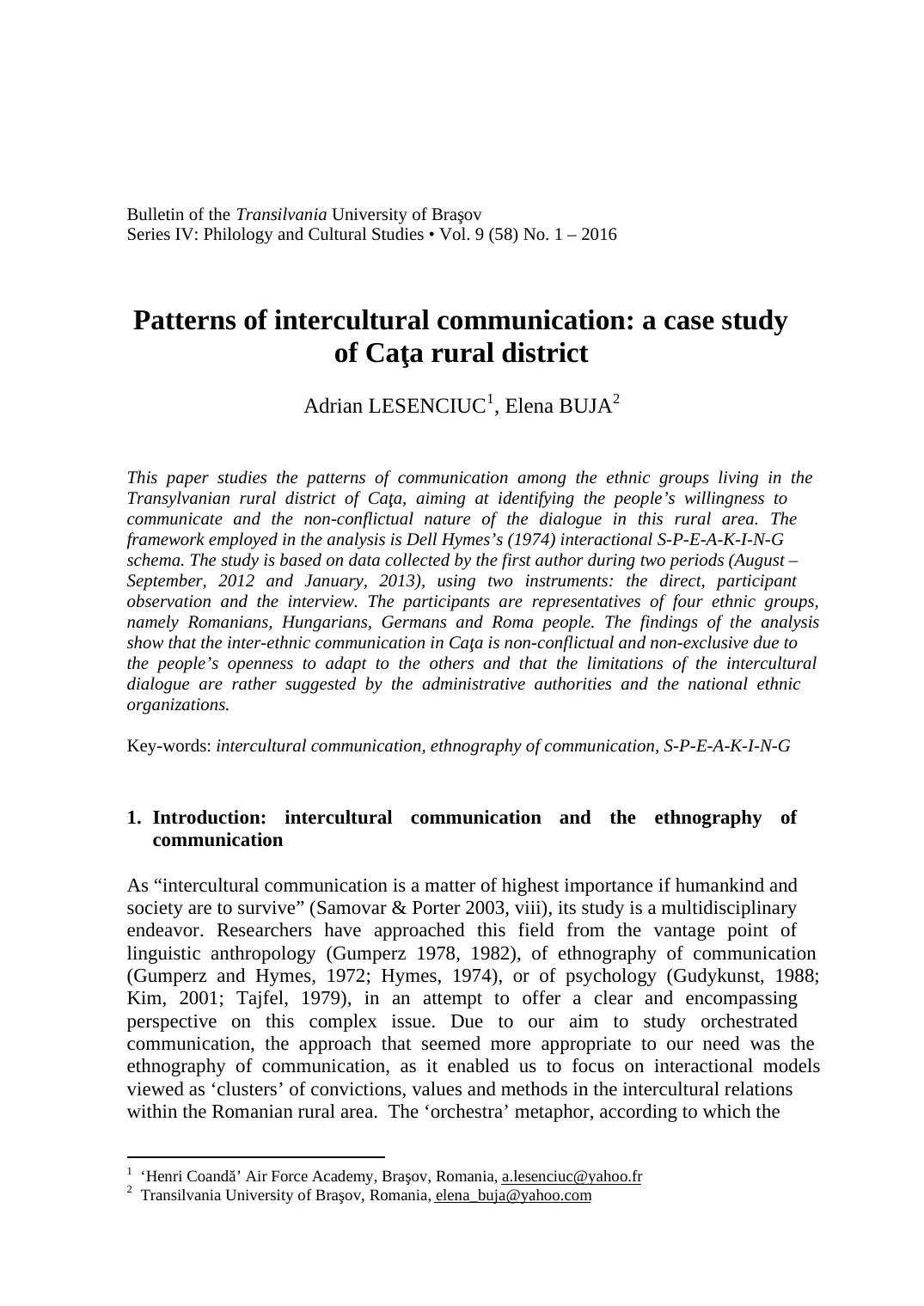
Bulletin of the Transilvania University of Braşov
Series IV: Philology and Cultural Studies • Vol. 9 (58) No. 1 – 2016
Patterns of intercultural communication: a case study
of Caţa rural district
Adrian LESENCIUC1, Elena BUJA2
This paper studies the patterns of communication among the ethnic groups living in the
Transylvanian rural district of Caţa, aiming at identifying the people’s willingness to
communicate and the non-conflictual nature of the dialogue in this rural area. The
framework employed in the analysis is Dell Hymes’s (1974) interactional S-P-E-A-K-I-N-G
schema. The study is based on data collected by the first author during two periods (August –
September, 2012 and January, 2013), using two instruments: the direct, participant
observation and the interview. The participants are representatives of four ethnic groups,
namely Romanians, Hungarians, Germans and Roma people. The findings of the analysis
show that the inter-ethnic communication in Caţa is non-conflictual and non-exclusive due to
the people’s openness to adapt to the others and that the limitations of the intercultural
dialogue are rather suggested by the administrative authorities and the national ethnic
organizations.
Key-words: intercultural communication, ethnography of communication, S-P-E-A-K-I-N-G
1. Introduction: intercultural communication and the ethnography of
communication
As “intercultural communication is a matter of highest importance if humankind and
society are to survive” (Samovar & Porter 2003, viii), its study is a multidisciplinary
endeavor. Researchers have approached this field from the vantage point of
linguistic anthropology (Gumperz 1978, 1982), of ethnography of communication
(Gumperz and Hymes, 1972; Hymes, 1974), or of psychology (Gudykunst, 1988;
Kim, 2001; Tajfel, 1979), in an attempt to offer a clear and encompassing
perspective on this complex issue. Due to our aim to study orchestrated
communication, the approach that seemed more appropriate to our need was the
ethnography of communication, as it enabled us to focus on interactional models
viewed as ‘clusters’ of convictions, values and methods in the intercultural relations
within the Romanian rural area. The ‘orchestra’ metaphor, according to which the
1 ‘Henri Coandă’ Air Force Academy, Braşov, Romania, a.lesenciuc@yahoo.fr
2 Transilvania University of Braşov, Romania, elena_buja@yahoo.com
Series IV: Philology and Cultural Studies • Vol. 9 (58) No. 1 – 2016
Patterns of intercultural communication: a case study
of Caţa rural district
Adrian LESENCIUC1, Elena BUJA2
This paper studies the patterns of communication among the ethnic groups living in the
Transylvanian rural district of Caţa, aiming at identifying the people’s willingness to
communicate and the non-conflictual nature of the dialogue in this rural area. The
framework employed in the analysis is Dell Hymes’s (1974) interactional S-P-E-A-K-I-N-G
schema. The study is based on data collected by the first author during two periods (August –
September, 2012 and January, 2013), using two instruments: the direct, participant
observation and the interview. The participants are representatives of four ethnic groups,
namely Romanians, Hungarians, Germans and Roma people. The findings of the analysis
show that the inter-ethnic communication in Caţa is non-conflictual and non-exclusive due to
the people’s openness to adapt to the others and that the limitations of the intercultural
dialogue are rather suggested by the administrative authorities and the national ethnic
organizations.
Key-words: intercultural communication, ethnography of communication, S-P-E-A-K-I-N-G
1. Introduction: intercultural communication and the ethnography of
communication
As “intercultural communication is a matter of highest importance if humankind and
society are to survive” (Samovar & Porter 2003, viii), its study is a multidisciplinary
endeavor. Researchers have approached this field from the vantage point of
linguistic anthropology (Gumperz 1978, 1982), of ethnography of communication
(Gumperz and Hymes, 1972; Hymes, 1974), or of psychology (Gudykunst, 1988;
Kim, 2001; Tajfel, 1979), in an attempt to offer a clear and encompassing
perspective on this complex issue. Due to our aim to study orchestrated
communication, the approach that seemed more appropriate to our need was the
ethnography of communication, as it enabled us to focus on interactional models
viewed as ‘clusters’ of convictions, values and methods in the intercultural relations
within the Romanian rural area. The ‘orchestra’ metaphor, according to which the
1 ‘Henri Coandă’ Air Force Academy, Braşov, Romania, a.lesenciuc@yahoo.fr
2 Transilvania University of Braşov, Romania, elena_buja@yahoo.com
Secure Best Marks with AI Grader
Need help grading? Try our AI Grader for instant feedback on your assignments.
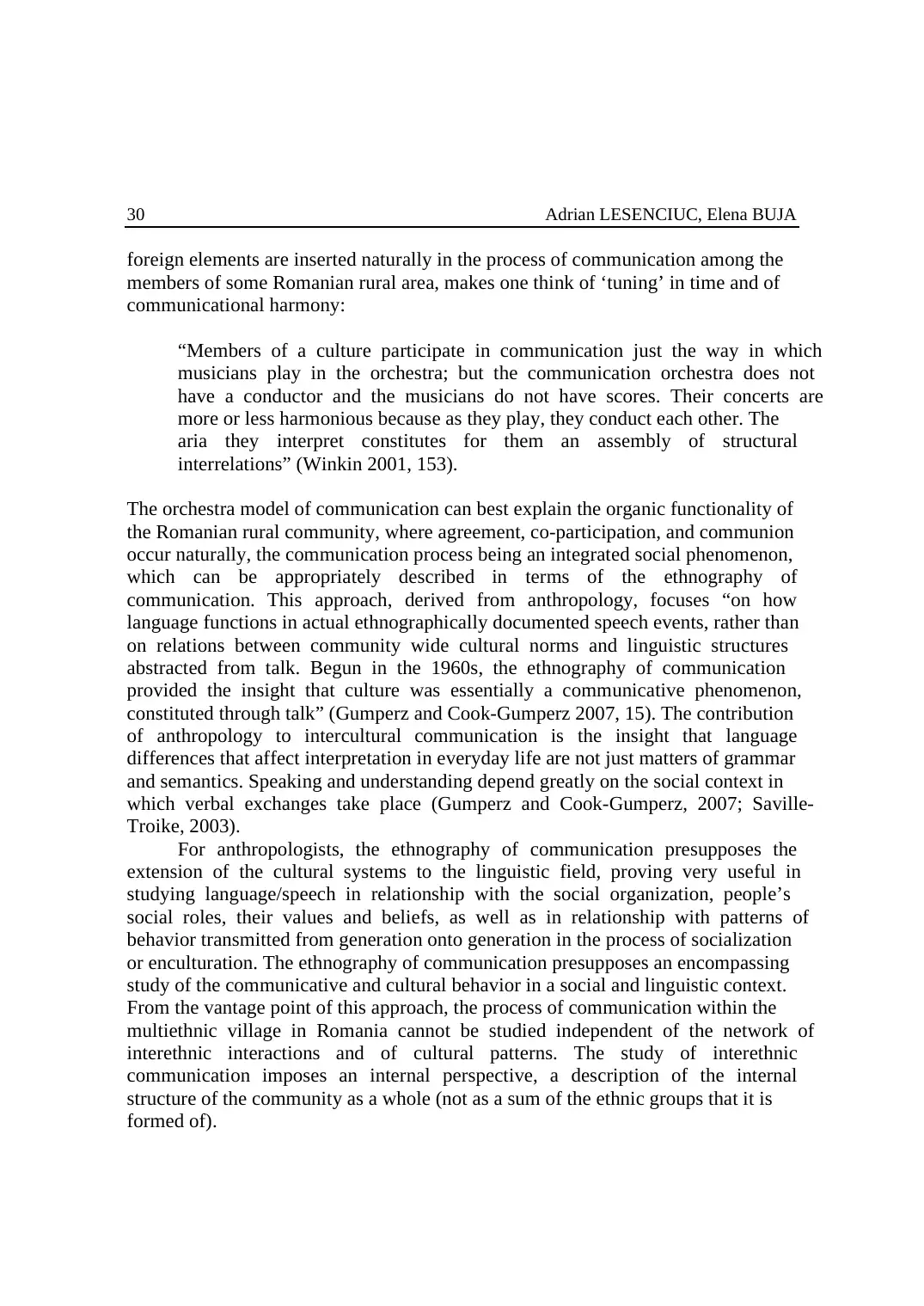
Adrian LESENCIUC, Elena BUJA30
foreign elements are inserted naturally in the process of communication among the
members of some Romanian rural area, makes one think of ‘tuning’ in time and of
communicational harmony:
“Members of a culture participate in communication just the way in which
musicians play in the orchestra; but the communication orchestra does not
have a conductor and the musicians do not have scores. Their concerts are
more or less harmonious because as they play, they conduct each other. The
aria they interpret constitutes for them an assembly of structural
interrelations” (Winkin 2001, 153).
The orchestra model of communication can best explain the organic functionality of
the Romanian rural community, where agreement, co-participation, and communion
occur naturally, the communication process being an integrated social phenomenon,
which can be appropriately described in terms of the ethnography of
communication. This approach, derived from anthropology, focuses “on how
language functions in actual ethnographically documented speech events, rather than
on relations between community wide cultural norms and linguistic structures
abstracted from talk. Begun in the 1960s, the ethnography of communication
provided the insight that culture was essentially a communicative phenomenon,
constituted through talk” (Gumperz and Cook-Gumperz 2007, 15). The contribution
of anthropology to intercultural communication is the insight that language
differences that affect interpretation in everyday life are not just matters of grammar
and semantics. Speaking and understanding depend greatly on the social context in
which verbal exchanges take place (Gumperz and Cook-Gumperz, 2007; Saville-
Troike, 2003).
For anthropologists, the ethnography of communication presupposes the
extension of the cultural systems to the linguistic field, proving very useful in
studying language/speech in relationship with the social organization, people’s
social roles, their values and beliefs, as well as in relationship with patterns of
behavior transmitted from generation onto generation in the process of socialization
or enculturation. The ethnography of communication presupposes an encompassing
study of the communicative and cultural behavior in a social and linguistic context.
From the vantage point of this approach, the process of communication within the
multiethnic village in Romania cannot be studied independent of the network of
interethnic interactions and of cultural patterns. The study of interethnic
communication imposes an internal perspective, a description of the internal
structure of the community as a whole (not as a sum of the ethnic groups that it is
formed of).
foreign elements are inserted naturally in the process of communication among the
members of some Romanian rural area, makes one think of ‘tuning’ in time and of
communicational harmony:
“Members of a culture participate in communication just the way in which
musicians play in the orchestra; but the communication orchestra does not
have a conductor and the musicians do not have scores. Their concerts are
more or less harmonious because as they play, they conduct each other. The
aria they interpret constitutes for them an assembly of structural
interrelations” (Winkin 2001, 153).
The orchestra model of communication can best explain the organic functionality of
the Romanian rural community, where agreement, co-participation, and communion
occur naturally, the communication process being an integrated social phenomenon,
which can be appropriately described in terms of the ethnography of
communication. This approach, derived from anthropology, focuses “on how
language functions in actual ethnographically documented speech events, rather than
on relations between community wide cultural norms and linguistic structures
abstracted from talk. Begun in the 1960s, the ethnography of communication
provided the insight that culture was essentially a communicative phenomenon,
constituted through talk” (Gumperz and Cook-Gumperz 2007, 15). The contribution
of anthropology to intercultural communication is the insight that language
differences that affect interpretation in everyday life are not just matters of grammar
and semantics. Speaking and understanding depend greatly on the social context in
which verbal exchanges take place (Gumperz and Cook-Gumperz, 2007; Saville-
Troike, 2003).
For anthropologists, the ethnography of communication presupposes the
extension of the cultural systems to the linguistic field, proving very useful in
studying language/speech in relationship with the social organization, people’s
social roles, their values and beliefs, as well as in relationship with patterns of
behavior transmitted from generation onto generation in the process of socialization
or enculturation. The ethnography of communication presupposes an encompassing
study of the communicative and cultural behavior in a social and linguistic context.
From the vantage point of this approach, the process of communication within the
multiethnic village in Romania cannot be studied independent of the network of
interethnic interactions and of cultural patterns. The study of interethnic
communication imposes an internal perspective, a description of the internal
structure of the community as a whole (not as a sum of the ethnic groups that it is
formed of).
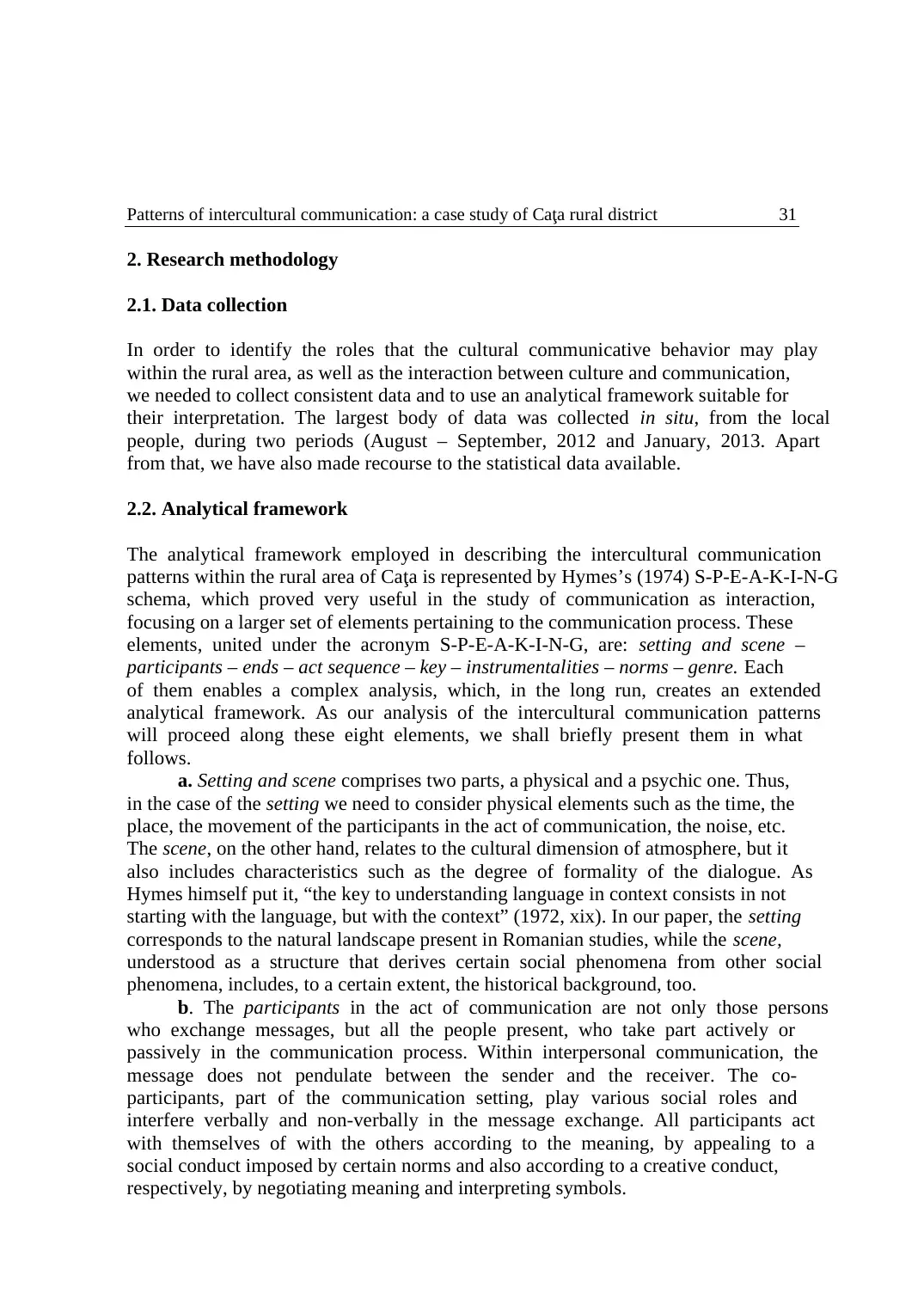
Patterns of intercultural communication: a case study of Caţa rural district 31
2. Research methodology
2.1. Data collection
In order to identify the roles that the cultural communicative behavior may play
within the rural area, as well as the interaction between culture and communication,
we needed to collect consistent data and to use an analytical framework suitable for
their interpretation. The largest body of data was collected in situ, from the local
people, during two periods (August – September, 2012 and January, 2013. Apart
from that, we have also made recourse to the statistical data available.
2.2. Analytical framework
The analytical framework employed in describing the intercultural communication
patterns within the rural area of Caţa is represented by Hymes’s (1974) S-P-E-A-K-I-N-G
schema, which proved very useful in the study of communication as interaction,
focusing on a larger set of elements pertaining to the communication process. These
elements, united under the acronym S-P-E-A-K-I-N-G, are: setting and scene –
participants – ends – act sequence – key – instrumentalities – norms – genre. Each
of them enables a complex analysis, which, in the long run, creates an extended
analytical framework. As our analysis of the intercultural communication patterns
will proceed along these eight elements, we shall briefly present them in what
follows.
a. Setting and scene comprises two parts, a physical and a psychic one. Thus,
in the case of the setting we need to consider physical elements such as the time, the
place, the movement of the participants in the act of communication, the noise, etc.
The scene, on the other hand, relates to the cultural dimension of atmosphere, but it
also includes characteristics such as the degree of formality of the dialogue. As
Hymes himself put it, “the key to understanding language in context consists in not
starting with the language, but with the context” (1972, xix). In our paper, the setting
corresponds to the natural landscape present in Romanian studies, while the scene,
understood as a structure that derives certain social phenomena from other social
phenomena, includes, to a certain extent, the historical background, too.
b. The participants in the act of communication are not only those persons
who exchange messages, but all the people present, who take part actively or
passively in the communication process. Within interpersonal communication, the
message does not pendulate between the sender and the receiver. The co-
participants, part of the communication setting, play various social roles and
interfere verbally and non-verbally in the message exchange. All participants act
with themselves of with the others according to the meaning, by appealing to a
social conduct imposed by certain norms and also according to a creative conduct,
respectively, by negotiating meaning and interpreting symbols.
2. Research methodology
2.1. Data collection
In order to identify the roles that the cultural communicative behavior may play
within the rural area, as well as the interaction between culture and communication,
we needed to collect consistent data and to use an analytical framework suitable for
their interpretation. The largest body of data was collected in situ, from the local
people, during two periods (August – September, 2012 and January, 2013. Apart
from that, we have also made recourse to the statistical data available.
2.2. Analytical framework
The analytical framework employed in describing the intercultural communication
patterns within the rural area of Caţa is represented by Hymes’s (1974) S-P-E-A-K-I-N-G
schema, which proved very useful in the study of communication as interaction,
focusing on a larger set of elements pertaining to the communication process. These
elements, united under the acronym S-P-E-A-K-I-N-G, are: setting and scene –
participants – ends – act sequence – key – instrumentalities – norms – genre. Each
of them enables a complex analysis, which, in the long run, creates an extended
analytical framework. As our analysis of the intercultural communication patterns
will proceed along these eight elements, we shall briefly present them in what
follows.
a. Setting and scene comprises two parts, a physical and a psychic one. Thus,
in the case of the setting we need to consider physical elements such as the time, the
place, the movement of the participants in the act of communication, the noise, etc.
The scene, on the other hand, relates to the cultural dimension of atmosphere, but it
also includes characteristics such as the degree of formality of the dialogue. As
Hymes himself put it, “the key to understanding language in context consists in not
starting with the language, but with the context” (1972, xix). In our paper, the setting
corresponds to the natural landscape present in Romanian studies, while the scene,
understood as a structure that derives certain social phenomena from other social
phenomena, includes, to a certain extent, the historical background, too.
b. The participants in the act of communication are not only those persons
who exchange messages, but all the people present, who take part actively or
passively in the communication process. Within interpersonal communication, the
message does not pendulate between the sender and the receiver. The co-
participants, part of the communication setting, play various social roles and
interfere verbally and non-verbally in the message exchange. All participants act
with themselves of with the others according to the meaning, by appealing to a
social conduct imposed by certain norms and also according to a creative conduct,
respectively, by negotiating meaning and interpreting symbols.
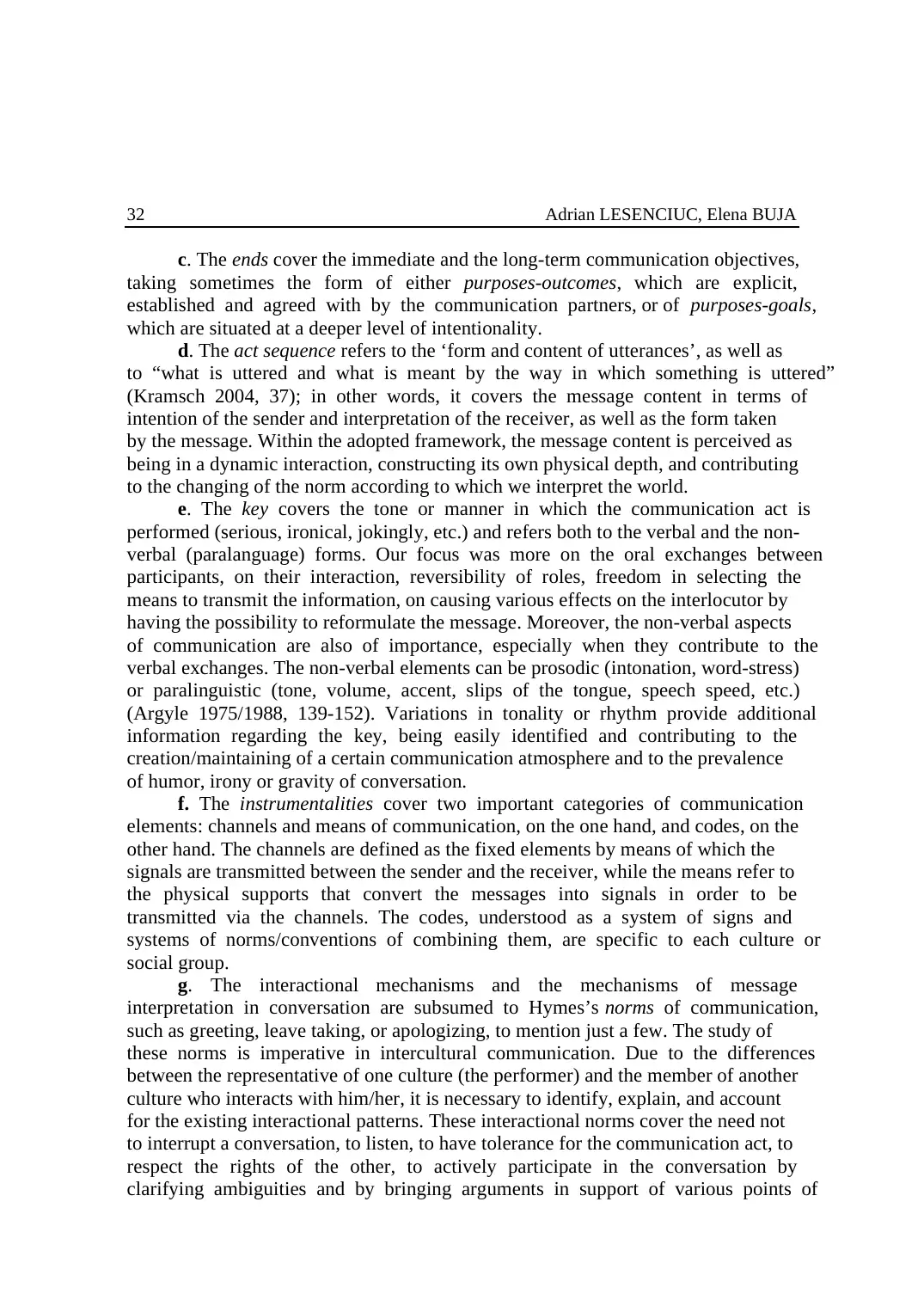
Adrian LESENCIUC, Elena BUJA32
c. The ends cover the immediate and the long-term communication objectives,
taking sometimes the form of either purposes-outcomes, which are explicit,
established and agreed with by the communication partners, or of purposes-goals,
which are situated at a deeper level of intentionality.
d. The act sequence refers to the ‘form and content of utterances’, as well as
to “what is uttered and what is meant by the way in which something is uttered”
(Kramsch 2004, 37); in other words, it covers the message content in terms of
intention of the sender and interpretation of the receiver, as well as the form taken
by the message. Within the adopted framework, the message content is perceived as
being in a dynamic interaction, constructing its own physical depth, and contributing
to the changing of the norm according to which we interpret the world.
e. The key covers the tone or manner in which the communication act is
performed (serious, ironical, jokingly, etc.) and refers both to the verbal and the non-
verbal (paralanguage) forms. Our focus was more on the oral exchanges between
participants, on their interaction, reversibility of roles, freedom in selecting the
means to transmit the information, on causing various effects on the interlocutor by
having the possibility to reformulate the message. Moreover, the non-verbal aspects
of communication are also of importance, especially when they contribute to the
verbal exchanges. The non-verbal elements can be prosodic (intonation, word-stress)
or paralinguistic (tone, volume, accent, slips of the tongue, speech speed, etc.)
(Argyle 1975/1988, 139-152). Variations in tonality or rhythm provide additional
information regarding the key, being easily identified and contributing to the
creation/maintaining of a certain communication atmosphere and to the prevalence
of humor, irony or gravity of conversation.
f. The instrumentalities cover two important categories of communication
elements: channels and means of communication, on the one hand, and codes, on the
other hand. The channels are defined as the fixed elements by means of which the
signals are transmitted between the sender and the receiver, while the means refer to
the physical supports that convert the messages into signals in order to be
transmitted via the channels. The codes, understood as a system of signs and
systems of norms/conventions of combining them, are specific to each culture or
social group.
g. The interactional mechanisms and the mechanisms of message
interpretation in conversation are subsumed to Hymes’s norms of communication,
such as greeting, leave taking, or apologizing, to mention just a few. The study of
these norms is imperative in intercultural communication. Due to the differences
between the representative of one culture (the performer) and the member of another
culture who interacts with him/her, it is necessary to identify, explain, and account
for the existing interactional patterns. These interactional norms cover the need not
to interrupt a conversation, to listen, to have tolerance for the communication act, to
respect the rights of the other, to actively participate in the conversation by
clarifying ambiguities and by bringing arguments in support of various points of
c. The ends cover the immediate and the long-term communication objectives,
taking sometimes the form of either purposes-outcomes, which are explicit,
established and agreed with by the communication partners, or of purposes-goals,
which are situated at a deeper level of intentionality.
d. The act sequence refers to the ‘form and content of utterances’, as well as
to “what is uttered and what is meant by the way in which something is uttered”
(Kramsch 2004, 37); in other words, it covers the message content in terms of
intention of the sender and interpretation of the receiver, as well as the form taken
by the message. Within the adopted framework, the message content is perceived as
being in a dynamic interaction, constructing its own physical depth, and contributing
to the changing of the norm according to which we interpret the world.
e. The key covers the tone or manner in which the communication act is
performed (serious, ironical, jokingly, etc.) and refers both to the verbal and the non-
verbal (paralanguage) forms. Our focus was more on the oral exchanges between
participants, on their interaction, reversibility of roles, freedom in selecting the
means to transmit the information, on causing various effects on the interlocutor by
having the possibility to reformulate the message. Moreover, the non-verbal aspects
of communication are also of importance, especially when they contribute to the
verbal exchanges. The non-verbal elements can be prosodic (intonation, word-stress)
or paralinguistic (tone, volume, accent, slips of the tongue, speech speed, etc.)
(Argyle 1975/1988, 139-152). Variations in tonality or rhythm provide additional
information regarding the key, being easily identified and contributing to the
creation/maintaining of a certain communication atmosphere and to the prevalence
of humor, irony or gravity of conversation.
f. The instrumentalities cover two important categories of communication
elements: channels and means of communication, on the one hand, and codes, on the
other hand. The channels are defined as the fixed elements by means of which the
signals are transmitted between the sender and the receiver, while the means refer to
the physical supports that convert the messages into signals in order to be
transmitted via the channels. The codes, understood as a system of signs and
systems of norms/conventions of combining them, are specific to each culture or
social group.
g. The interactional mechanisms and the mechanisms of message
interpretation in conversation are subsumed to Hymes’s norms of communication,
such as greeting, leave taking, or apologizing, to mention just a few. The study of
these norms is imperative in intercultural communication. Due to the differences
between the representative of one culture (the performer) and the member of another
culture who interacts with him/her, it is necessary to identify, explain, and account
for the existing interactional patterns. These interactional norms cover the need not
to interrupt a conversation, to listen, to have tolerance for the communication act, to
respect the rights of the other, to actively participate in the conversation by
clarifying ambiguities and by bringing arguments in support of various points of
Secure Best Marks with AI Grader
Need help grading? Try our AI Grader for instant feedback on your assignments.
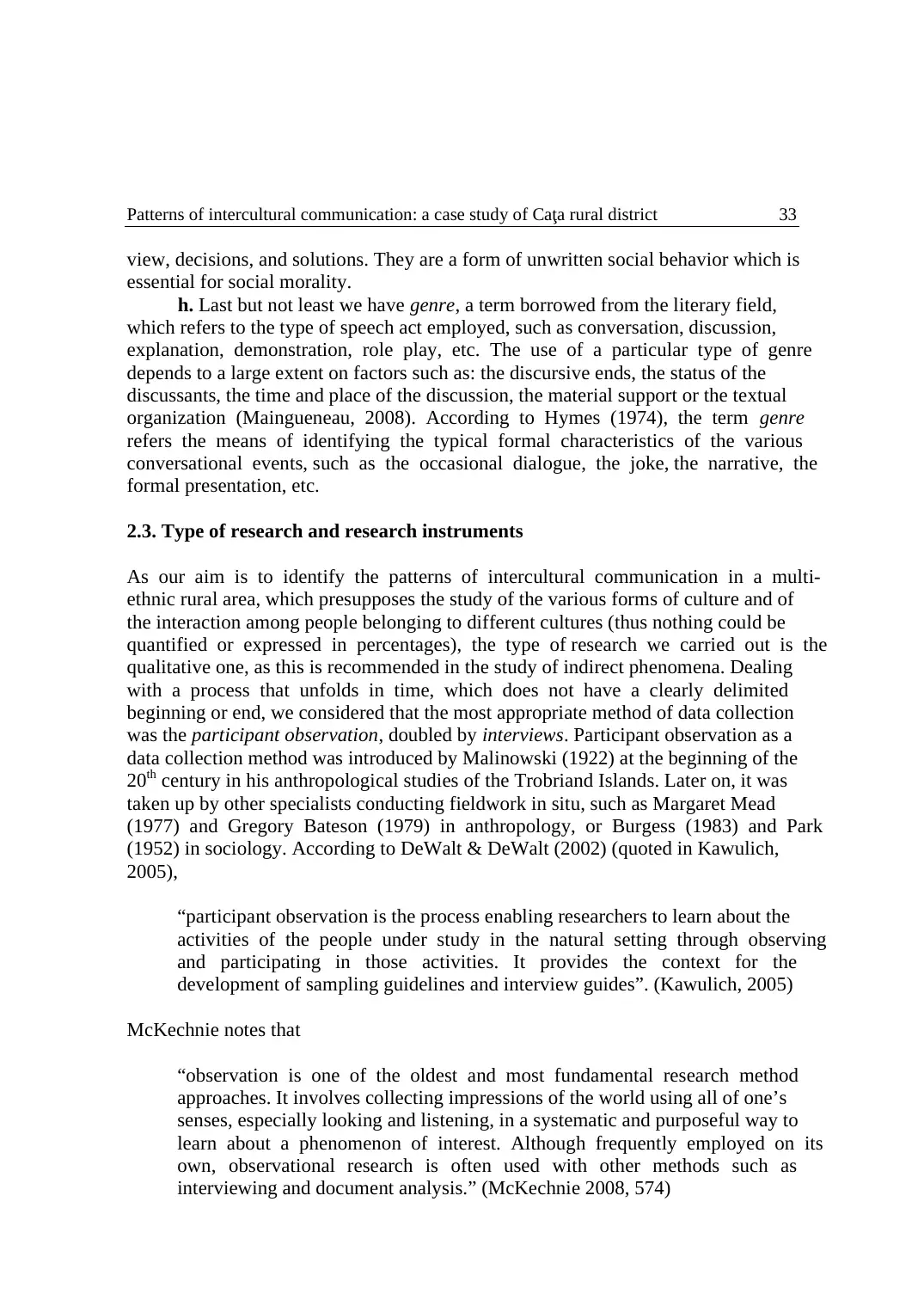
Patterns of intercultural communication: a case study of Caţa rural district 33
view, decisions, and solutions. They are a form of unwritten social behavior which is
essential for social morality.
h. Last but not least we have genre, a term borrowed from the literary field,
which refers to the type of speech act employed, such as conversation, discussion,
explanation, demonstration, role play, etc. The use of a particular type of genre
depends to a large extent on factors such as: the discursive ends, the status of the
discussants, the time and place of the discussion, the material support or the textual
organization (Maingueneau, 2008). According to Hymes (1974), the term genre
refers the means of identifying the typical formal characteristics of the various
conversational events, such as the occasional dialogue, the joke, the narrative, the
formal presentation, etc.
2.3. Type of research and research instruments
As our aim is to identify the patterns of intercultural communication in a multi-
ethnic rural area, which presupposes the study of the various forms of culture and of
the interaction among people belonging to different cultures (thus nothing could be
quantified or expressed in percentages), the type of research we carried out is the
qualitative one, as this is recommended in the study of indirect phenomena. Dealing
with a process that unfolds in time, which does not have a clearly delimited
beginning or end, we considered that the most appropriate method of data collection
was the participant observation, doubled by interviews. Participant observation as a
data collection method was introduced by Malinowski (1922) at the beginning of the
20th century in his anthropological studies of the Trobriand Islands. Later on, it was
taken up by other specialists conducting fieldwork in situ, such as Margaret Mead
(1977) and Gregory Bateson (1979) in anthropology, or Burgess (1983) and Park
(1952) in sociology. According to DeWalt & DeWalt (2002) (quoted in Kawulich,
2005),
“participant observation is the process enabling researchers to learn about the
activities of the people under study in the natural setting through observing
and participating in those activities. It provides the context for the
development of sampling guidelines and interview guides”. (Kawulich, 2005)
McKechnie notes that
“observation is one of the oldest and most fundamental research method
approaches. It involves collecting impressions of the world using all of one’s
senses, especially looking and listening, in a systematic and purposeful way to
learn about a phenomenon of interest. Although frequently employed on its
own, observational research is often used with other methods such as
interviewing and document analysis.” (McKechnie 2008, 574)
view, decisions, and solutions. They are a form of unwritten social behavior which is
essential for social morality.
h. Last but not least we have genre, a term borrowed from the literary field,
which refers to the type of speech act employed, such as conversation, discussion,
explanation, demonstration, role play, etc. The use of a particular type of genre
depends to a large extent on factors such as: the discursive ends, the status of the
discussants, the time and place of the discussion, the material support or the textual
organization (Maingueneau, 2008). According to Hymes (1974), the term genre
refers the means of identifying the typical formal characteristics of the various
conversational events, such as the occasional dialogue, the joke, the narrative, the
formal presentation, etc.
2.3. Type of research and research instruments
As our aim is to identify the patterns of intercultural communication in a multi-
ethnic rural area, which presupposes the study of the various forms of culture and of
the interaction among people belonging to different cultures (thus nothing could be
quantified or expressed in percentages), the type of research we carried out is the
qualitative one, as this is recommended in the study of indirect phenomena. Dealing
with a process that unfolds in time, which does not have a clearly delimited
beginning or end, we considered that the most appropriate method of data collection
was the participant observation, doubled by interviews. Participant observation as a
data collection method was introduced by Malinowski (1922) at the beginning of the
20th century in his anthropological studies of the Trobriand Islands. Later on, it was
taken up by other specialists conducting fieldwork in situ, such as Margaret Mead
(1977) and Gregory Bateson (1979) in anthropology, or Burgess (1983) and Park
(1952) in sociology. According to DeWalt & DeWalt (2002) (quoted in Kawulich,
2005),
“participant observation is the process enabling researchers to learn about the
activities of the people under study in the natural setting through observing
and participating in those activities. It provides the context for the
development of sampling guidelines and interview guides”. (Kawulich, 2005)
McKechnie notes that
“observation is one of the oldest and most fundamental research method
approaches. It involves collecting impressions of the world using all of one’s
senses, especially looking and listening, in a systematic and purposeful way to
learn about a phenomenon of interest. Although frequently employed on its
own, observational research is often used with other methods such as
interviewing and document analysis.” (McKechnie 2008, 574)
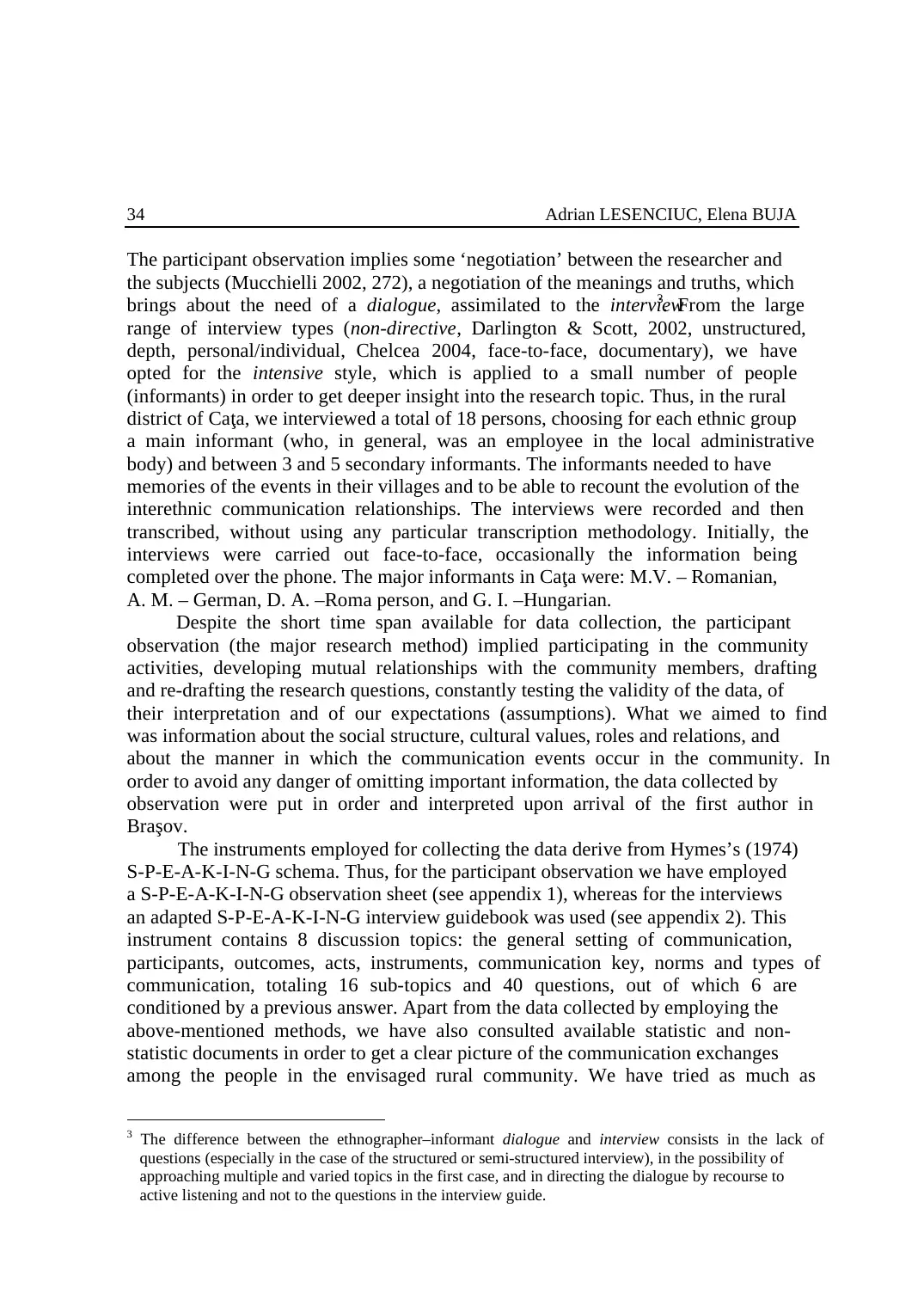
Adrian LESENCIUC, Elena BUJA34
The participant observation implies some ‘negotiation’ between the researcher and
the subjects (Mucchielli 2002, 272), a negotiation of the meanings and truths, which
brings about the need of a dialogue, assimilated to the interview3. From the large
range of interview types (non-directive, Darlington & Scott, 2002, unstructured,
depth, personal/individual, Chelcea 2004, face-to-face, documentary), we have
opted for the intensive style, which is applied to a small number of people
(informants) in order to get deeper insight into the research topic. Thus, in the rural
district of Caţa, we interviewed a total of 18 persons, choosing for each ethnic group
a main informant (who, in general, was an employee in the local administrative
body) and between 3 and 5 secondary informants. The informants needed to have
memories of the events in their villages and to be able to recount the evolution of the
interethnic communication relationships. The interviews were recorded and then
transcribed, without using any particular transcription methodology. Initially, the
interviews were carried out face-to-face, occasionally the information being
completed over the phone. The major informants in Caţa were: M.V. – Romanian,
A. M. – German, D. A. –Roma person, and G. I. –Hungarian.
Despite the short time span available for data collection, the participant
observation (the major research method) implied participating in the community
activities, developing mutual relationships with the community members, drafting
and re-drafting the research questions, constantly testing the validity of the data, of
their interpretation and of our expectations (assumptions). What we aimed to find
was information about the social structure, cultural values, roles and relations, and
about the manner in which the communication events occur in the community. In
order to avoid any danger of omitting important information, the data collected by
observation were put in order and interpreted upon arrival of the first author in
Braşov.
The instruments employed for collecting the data derive from Hymes’s (1974)
S-P-E-A-K-I-N-G schema. Thus, for the participant observation we have employed
a S-P-E-A-K-I-N-G observation sheet (see appendix 1), whereas for the interviews
an adapted S-P-E-A-K-I-N-G interview guidebook was used (see appendix 2). This
instrument contains 8 discussion topics: the general setting of communication,
participants, outcomes, acts, instruments, communication key, norms and types of
communication, totaling 16 sub-topics and 40 questions, out of which 6 are
conditioned by a previous answer. Apart from the data collected by employing the
above-mentioned methods, we have also consulted available statistic and non-
statistic documents in order to get a clear picture of the communication exchanges
among the people in the envisaged rural community. We have tried as much as
3 The difference between the ethnographer–informant dialogue and interview consists in the lack of
questions (especially in the case of the structured or semi-structured interview), in the possibility of
approaching multiple and varied topics in the first case, and in directing the dialogue by recourse to
active listening and not to the questions in the interview guide.
The participant observation implies some ‘negotiation’ between the researcher and
the subjects (Mucchielli 2002, 272), a negotiation of the meanings and truths, which
brings about the need of a dialogue, assimilated to the interview3. From the large
range of interview types (non-directive, Darlington & Scott, 2002, unstructured,
depth, personal/individual, Chelcea 2004, face-to-face, documentary), we have
opted for the intensive style, which is applied to a small number of people
(informants) in order to get deeper insight into the research topic. Thus, in the rural
district of Caţa, we interviewed a total of 18 persons, choosing for each ethnic group
a main informant (who, in general, was an employee in the local administrative
body) and between 3 and 5 secondary informants. The informants needed to have
memories of the events in their villages and to be able to recount the evolution of the
interethnic communication relationships. The interviews were recorded and then
transcribed, without using any particular transcription methodology. Initially, the
interviews were carried out face-to-face, occasionally the information being
completed over the phone. The major informants in Caţa were: M.V. – Romanian,
A. M. – German, D. A. –Roma person, and G. I. –Hungarian.
Despite the short time span available for data collection, the participant
observation (the major research method) implied participating in the community
activities, developing mutual relationships with the community members, drafting
and re-drafting the research questions, constantly testing the validity of the data, of
their interpretation and of our expectations (assumptions). What we aimed to find
was information about the social structure, cultural values, roles and relations, and
about the manner in which the communication events occur in the community. In
order to avoid any danger of omitting important information, the data collected by
observation were put in order and interpreted upon arrival of the first author in
Braşov.
The instruments employed for collecting the data derive from Hymes’s (1974)
S-P-E-A-K-I-N-G schema. Thus, for the participant observation we have employed
a S-P-E-A-K-I-N-G observation sheet (see appendix 1), whereas for the interviews
an adapted S-P-E-A-K-I-N-G interview guidebook was used (see appendix 2). This
instrument contains 8 discussion topics: the general setting of communication,
participants, outcomes, acts, instruments, communication key, norms and types of
communication, totaling 16 sub-topics and 40 questions, out of which 6 are
conditioned by a previous answer. Apart from the data collected by employing the
above-mentioned methods, we have also consulted available statistic and non-
statistic documents in order to get a clear picture of the communication exchanges
among the people in the envisaged rural community. We have tried as much as
3 The difference between the ethnographer–informant dialogue and interview consists in the lack of
questions (especially in the case of the structured or semi-structured interview), in the possibility of
approaching multiple and varied topics in the first case, and in directing the dialogue by recourse to
active listening and not to the questions in the interview guide.
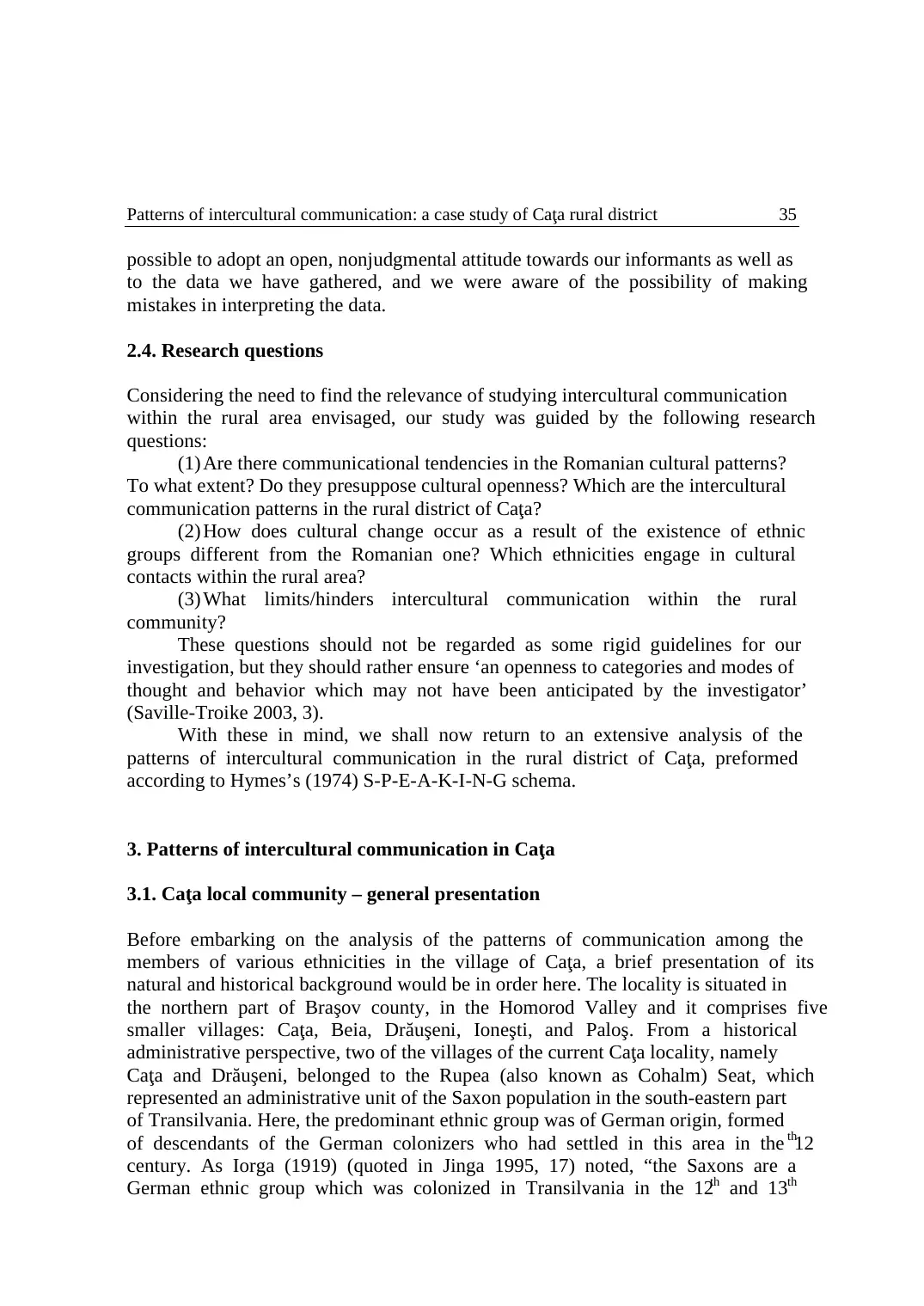
Patterns of intercultural communication: a case study of Caţa rural district 35
possible to adopt an open, nonjudgmental attitude towards our informants as well as
to the data we have gathered, and we were aware of the possibility of making
mistakes in interpreting the data.
2.4. Research questions
Considering the need to find the relevance of studying intercultural communication
within the rural area envisaged, our study was guided by the following research
questions:
(1) Are there communicational tendencies in the Romanian cultural patterns?
To what extent? Do they presuppose cultural openness? Which are the intercultural
communication patterns in the rural district of Caţa?
(2) How does cultural change occur as a result of the existence of ethnic
groups different from the Romanian one? Which ethnicities engage in cultural
contacts within the rural area?
(3) What limits/hinders intercultural communication within the rural
community?
These questions should not be regarded as some rigid guidelines for our
investigation, but they should rather ensure ‘an openness to categories and modes of
thought and behavior which may not have been anticipated by the investigator’
(Saville-Troike 2003, 3).
With these in mind, we shall now return to an extensive analysis of the
patterns of intercultural communication in the rural district of Caţa, preformed
according to Hymes’s (1974) S-P-E-A-K-I-N-G schema.
3. Patterns of intercultural communication in Caţa
3.1. Caţa local community – general presentation
Before embarking on the analysis of the patterns of communication among the
members of various ethnicities in the village of Caţa, a brief presentation of its
natural and historical background would be in order here. The locality is situated in
the northern part of Braşov county, in the Homorod Valley and it comprises five
smaller villages: Caţa, Beia, Drăuşeni, Ioneşti, and Paloş. From a historical
administrative perspective, two of the villages of the current Caţa locality, namely
Caţa and Drăuşeni, belonged to the Rupea (also known as Cohalm) Seat, which
represented an administrative unit of the Saxon population in the south-eastern part
of Transilvania. Here, the predominant ethnic group was of German origin, formed
of descendants of the German colonizers who had settled in this area in the 12th
century. As Iorga (1919) (quoted in Jinga 1995, 17) noted, “the Saxons are a
German ethnic group which was colonized in Transilvania in the 12th and 13th
possible to adopt an open, nonjudgmental attitude towards our informants as well as
to the data we have gathered, and we were aware of the possibility of making
mistakes in interpreting the data.
2.4. Research questions
Considering the need to find the relevance of studying intercultural communication
within the rural area envisaged, our study was guided by the following research
questions:
(1) Are there communicational tendencies in the Romanian cultural patterns?
To what extent? Do they presuppose cultural openness? Which are the intercultural
communication patterns in the rural district of Caţa?
(2) How does cultural change occur as a result of the existence of ethnic
groups different from the Romanian one? Which ethnicities engage in cultural
contacts within the rural area?
(3) What limits/hinders intercultural communication within the rural
community?
These questions should not be regarded as some rigid guidelines for our
investigation, but they should rather ensure ‘an openness to categories and modes of
thought and behavior which may not have been anticipated by the investigator’
(Saville-Troike 2003, 3).
With these in mind, we shall now return to an extensive analysis of the
patterns of intercultural communication in the rural district of Caţa, preformed
according to Hymes’s (1974) S-P-E-A-K-I-N-G schema.
3. Patterns of intercultural communication in Caţa
3.1. Caţa local community – general presentation
Before embarking on the analysis of the patterns of communication among the
members of various ethnicities in the village of Caţa, a brief presentation of its
natural and historical background would be in order here. The locality is situated in
the northern part of Braşov county, in the Homorod Valley and it comprises five
smaller villages: Caţa, Beia, Drăuşeni, Ioneşti, and Paloş. From a historical
administrative perspective, two of the villages of the current Caţa locality, namely
Caţa and Drăuşeni, belonged to the Rupea (also known as Cohalm) Seat, which
represented an administrative unit of the Saxon population in the south-eastern part
of Transilvania. Here, the predominant ethnic group was of German origin, formed
of descendants of the German colonizers who had settled in this area in the 12th
century. As Iorga (1919) (quoted in Jinga 1995, 17) noted, “the Saxons are a
German ethnic group which was colonized in Transilvania in the 12th and 13th
Paraphrase This Document
Need a fresh take? Get an instant paraphrase of this document with our AI Paraphraser
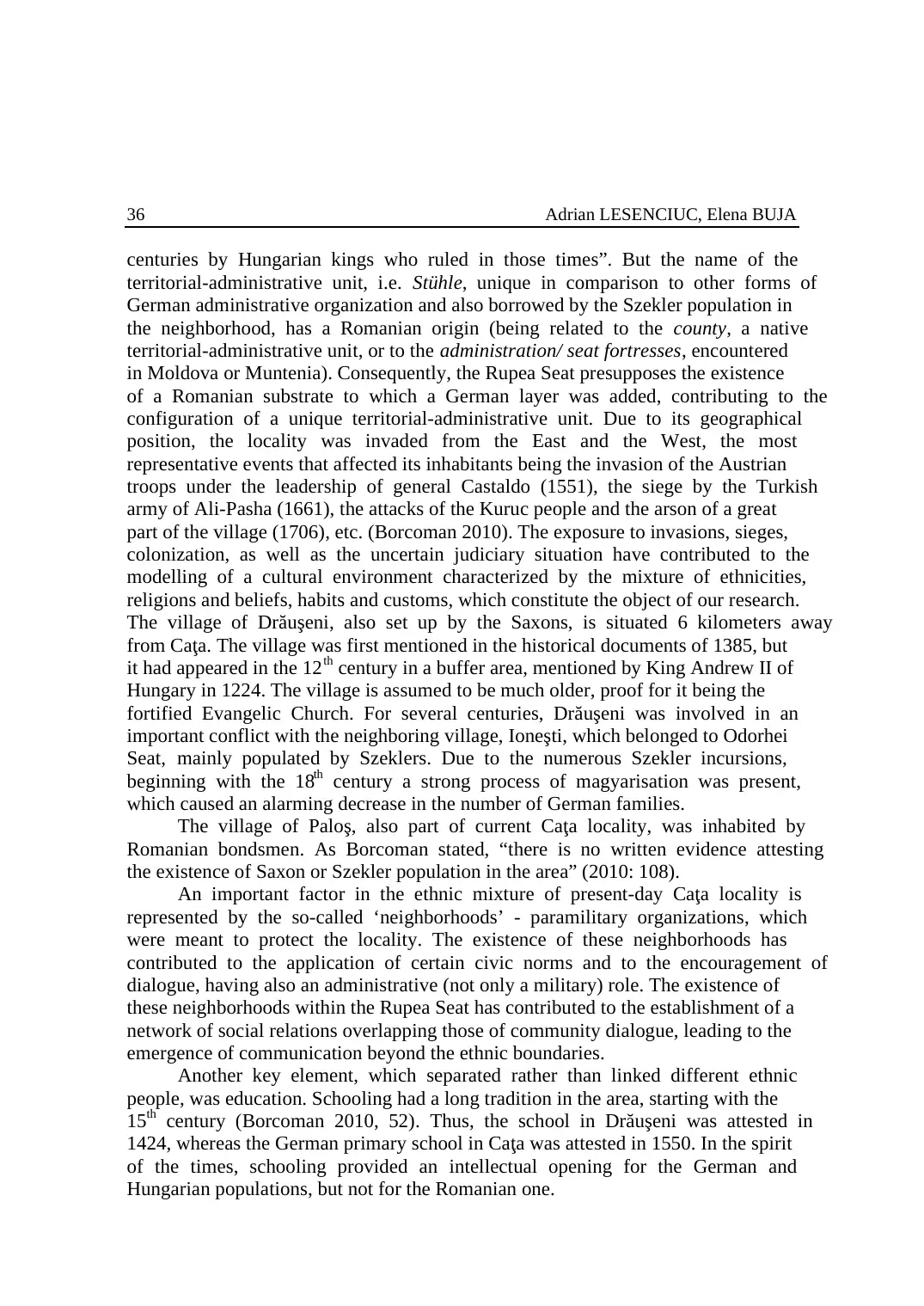
Adrian LESENCIUC, Elena BUJA36
centuries by Hungarian kings who ruled in those times”. But the name of the
territorial-administrative unit, i.e. Stühle, unique in comparison to other forms of
German administrative organization and also borrowed by the Szekler population in
the neighborhood, has a Romanian origin (being related to the county, a native
territorial-administrative unit, or to the administration/ seat fortresses, encountered
in Moldova or Muntenia). Consequently, the Rupea Seat presupposes the existence
of a Romanian substrate to which a German layer was added, contributing to the
configuration of a unique territorial-administrative unit. Due to its geographical
position, the locality was invaded from the East and the West, the most
representative events that affected its inhabitants being the invasion of the Austrian
troops under the leadership of general Castaldo (1551), the siege by the Turkish
army of Ali-Pasha (1661), the attacks of the Kuruc people and the arson of a great
part of the village (1706), etc. (Borcoman 2010). The exposure to invasions, sieges,
colonization, as well as the uncertain judiciary situation have contributed to the
modelling of a cultural environment characterized by the mixture of ethnicities,
religions and beliefs, habits and customs, which constitute the object of our research.
The village of Drăuşeni, also set up by the Saxons, is situated 6 kilometers away
from Caţa. The village was first mentioned in the historical documents of 1385, but
it had appeared in the 12th century in a buffer area, mentioned by King Andrew II of
Hungary in 1224. The village is assumed to be much older, proof for it being the
fortified Evangelic Church. For several centuries, Drăuşeni was involved in an
important conflict with the neighboring village, Ioneşti, which belonged to Odorhei
Seat, mainly populated by Szeklers. Due to the numerous Szekler incursions,
beginning with the 18th century a strong process of magyarisation was present,
which caused an alarming decrease in the number of German families.
The village of Paloş, also part of current Caţa locality, was inhabited by
Romanian bondsmen. As Borcoman stated, “there is no written evidence attesting
the existence of Saxon or Szekler population in the area” (2010: 108).
An important factor in the ethnic mixture of present-day Caţa locality is
represented by the so-called ‘neighborhoods’ - paramilitary organizations, which
were meant to protect the locality. The existence of these neighborhoods has
contributed to the application of certain civic norms and to the encouragement of
dialogue, having also an administrative (not only a military) role. The existence of
these neighborhoods within the Rupea Seat has contributed to the establishment of a
network of social relations overlapping those of community dialogue, leading to the
emergence of communication beyond the ethnic boundaries.
Another key element, which separated rather than linked different ethnic
people, was education. Schooling had a long tradition in the area, starting with the
15th century (Borcoman 2010, 52). Thus, the school in Drăuşeni was attested in
1424, whereas the German primary school in Caţa was attested in 1550. In the spirit
of the times, schooling provided an intellectual opening for the German and
Hungarian populations, but not for the Romanian one.
centuries by Hungarian kings who ruled in those times”. But the name of the
territorial-administrative unit, i.e. Stühle, unique in comparison to other forms of
German administrative organization and also borrowed by the Szekler population in
the neighborhood, has a Romanian origin (being related to the county, a native
territorial-administrative unit, or to the administration/ seat fortresses, encountered
in Moldova or Muntenia). Consequently, the Rupea Seat presupposes the existence
of a Romanian substrate to which a German layer was added, contributing to the
configuration of a unique territorial-administrative unit. Due to its geographical
position, the locality was invaded from the East and the West, the most
representative events that affected its inhabitants being the invasion of the Austrian
troops under the leadership of general Castaldo (1551), the siege by the Turkish
army of Ali-Pasha (1661), the attacks of the Kuruc people and the arson of a great
part of the village (1706), etc. (Borcoman 2010). The exposure to invasions, sieges,
colonization, as well as the uncertain judiciary situation have contributed to the
modelling of a cultural environment characterized by the mixture of ethnicities,
religions and beliefs, habits and customs, which constitute the object of our research.
The village of Drăuşeni, also set up by the Saxons, is situated 6 kilometers away
from Caţa. The village was first mentioned in the historical documents of 1385, but
it had appeared in the 12th century in a buffer area, mentioned by King Andrew II of
Hungary in 1224. The village is assumed to be much older, proof for it being the
fortified Evangelic Church. For several centuries, Drăuşeni was involved in an
important conflict with the neighboring village, Ioneşti, which belonged to Odorhei
Seat, mainly populated by Szeklers. Due to the numerous Szekler incursions,
beginning with the 18th century a strong process of magyarisation was present,
which caused an alarming decrease in the number of German families.
The village of Paloş, also part of current Caţa locality, was inhabited by
Romanian bondsmen. As Borcoman stated, “there is no written evidence attesting
the existence of Saxon or Szekler population in the area” (2010: 108).
An important factor in the ethnic mixture of present-day Caţa locality is
represented by the so-called ‘neighborhoods’ - paramilitary organizations, which
were meant to protect the locality. The existence of these neighborhoods has
contributed to the application of certain civic norms and to the encouragement of
dialogue, having also an administrative (not only a military) role. The existence of
these neighborhoods within the Rupea Seat has contributed to the establishment of a
network of social relations overlapping those of community dialogue, leading to the
emergence of communication beyond the ethnic boundaries.
Another key element, which separated rather than linked different ethnic
people, was education. Schooling had a long tradition in the area, starting with the
15th century (Borcoman 2010, 52). Thus, the school in Drăuşeni was attested in
1424, whereas the German primary school in Caţa was attested in 1550. In the spirit
of the times, schooling provided an intellectual opening for the German and
Hungarian populations, but not for the Romanian one.
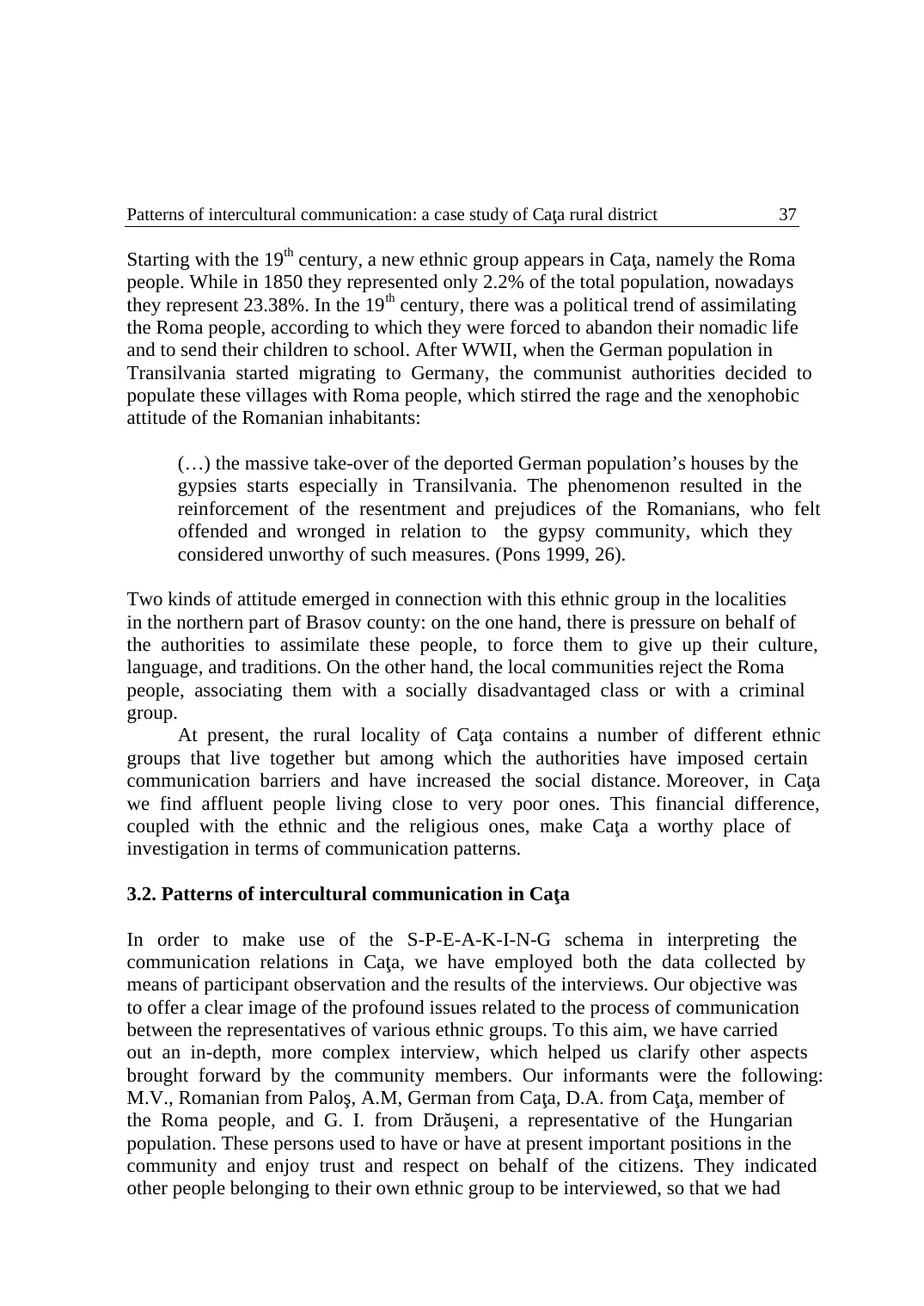
Patterns of intercultural communication: a case study of Caţa rural district 37
Starting with the 19th century, a new ethnic group appears in Caţa, namely the Roma
people. While in 1850 they represented only 2.2% of the total population, nowadays
they represent 23.38%. In the 19th century, there was a political trend of assimilating
the Roma people, according to which they were forced to abandon their nomadic life
and to send their children to school. After WWII, when the German population in
Transilvania started migrating to Germany, the communist authorities decided to
populate these villages with Roma people, which stirred the rage and the xenophobic
attitude of the Romanian inhabitants:
(…) the massive take-over of the deported German population’s houses by the
gypsies starts especially in Transilvania. The phenomenon resulted in the
reinforcement of the resentment and prejudices of the Romanians, who felt
offended and wronged in relation to the gypsy community, which they
considered unworthy of such measures. (Pons 1999, 26).
Two kinds of attitude emerged in connection with this ethnic group in the localities
in the northern part of Brasov county: on the one hand, there is pressure on behalf of
the authorities to assimilate these people, to force them to give up their culture,
language, and traditions. On the other hand, the local communities reject the Roma
people, associating them with a socially disadvantaged class or with a criminal
group.
At present, the rural locality of Caţa contains a number of different ethnic
groups that live together but among which the authorities have imposed certain
communication barriers and have increased the social distance. Moreover, in Caţa
we find affluent people living close to very poor ones. This financial difference,
coupled with the ethnic and the religious ones, make Caţa a worthy place of
investigation in terms of communication patterns.
3.2. Patterns of intercultural communication in Caţa
In order to make use of the S-P-E-A-K-I-N-G schema in interpreting the
communication relations in Caţa, we have employed both the data collected by
means of participant observation and the results of the interviews. Our objective was
to offer a clear image of the profound issues related to the process of communication
between the representatives of various ethnic groups. To this aim, we have carried
out an in-depth, more complex interview, which helped us clarify other aspects
brought forward by the community members. Our informants were the following:
M.V., Romanian from Paloş, A.M, German from Caţa, D.A. from Caţa, member of
the Roma people, and G. I. from Drăuşeni, a representative of the Hungarian
population. These persons used to have or have at present important positions in the
community and enjoy trust and respect on behalf of the citizens. They indicated
other people belonging to their own ethnic group to be interviewed, so that we had
Starting with the 19th century, a new ethnic group appears in Caţa, namely the Roma
people. While in 1850 they represented only 2.2% of the total population, nowadays
they represent 23.38%. In the 19th century, there was a political trend of assimilating
the Roma people, according to which they were forced to abandon their nomadic life
and to send their children to school. After WWII, when the German population in
Transilvania started migrating to Germany, the communist authorities decided to
populate these villages with Roma people, which stirred the rage and the xenophobic
attitude of the Romanian inhabitants:
(…) the massive take-over of the deported German population’s houses by the
gypsies starts especially in Transilvania. The phenomenon resulted in the
reinforcement of the resentment and prejudices of the Romanians, who felt
offended and wronged in relation to the gypsy community, which they
considered unworthy of such measures. (Pons 1999, 26).
Two kinds of attitude emerged in connection with this ethnic group in the localities
in the northern part of Brasov county: on the one hand, there is pressure on behalf of
the authorities to assimilate these people, to force them to give up their culture,
language, and traditions. On the other hand, the local communities reject the Roma
people, associating them with a socially disadvantaged class or with a criminal
group.
At present, the rural locality of Caţa contains a number of different ethnic
groups that live together but among which the authorities have imposed certain
communication barriers and have increased the social distance. Moreover, in Caţa
we find affluent people living close to very poor ones. This financial difference,
coupled with the ethnic and the religious ones, make Caţa a worthy place of
investigation in terms of communication patterns.
3.2. Patterns of intercultural communication in Caţa
In order to make use of the S-P-E-A-K-I-N-G schema in interpreting the
communication relations in Caţa, we have employed both the data collected by
means of participant observation and the results of the interviews. Our objective was
to offer a clear image of the profound issues related to the process of communication
between the representatives of various ethnic groups. To this aim, we have carried
out an in-depth, more complex interview, which helped us clarify other aspects
brought forward by the community members. Our informants were the following:
M.V., Romanian from Paloş, A.M, German from Caţa, D.A. from Caţa, member of
the Roma people, and G. I. from Drăuşeni, a representative of the Hungarian
population. These persons used to have or have at present important positions in the
community and enjoy trust and respect on behalf of the citizens. They indicated
other people belonging to their own ethnic group to be interviewed, so that we had
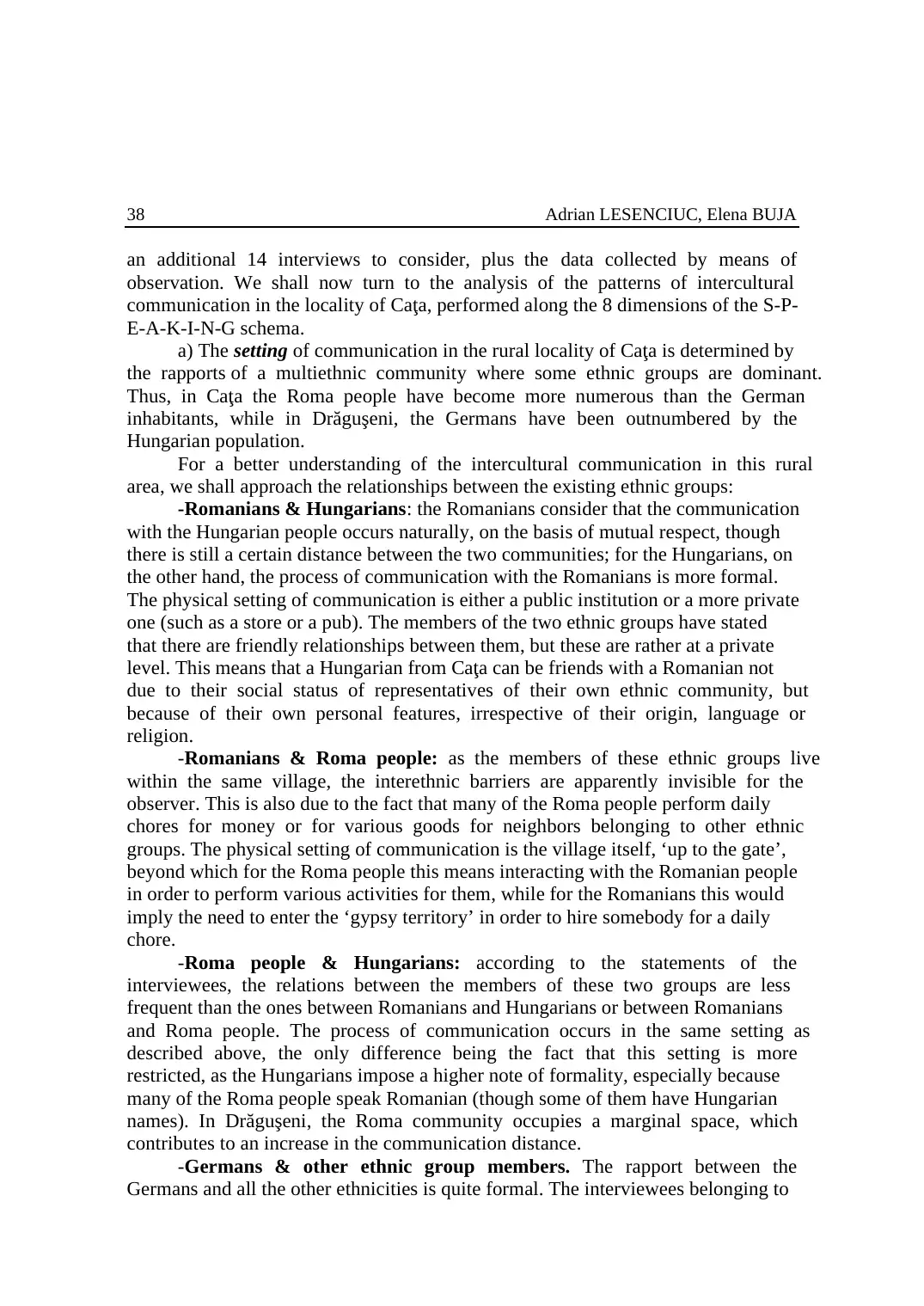
Adrian LESENCIUC, Elena BUJA38
an additional 14 interviews to consider, plus the data collected by means of
observation. We shall now turn to the analysis of the patterns of intercultural
communication in the locality of Caţa, performed along the 8 dimensions of the S-P-
E-A-K-I-N-G schema.
a) The setting of communication in the rural locality of Caţa is determined by
the rapports of a multiethnic community where some ethnic groups are dominant.
Thus, in Caţa the Roma people have become more numerous than the German
inhabitants, while in Drăguşeni, the Germans have been outnumbered by the
Hungarian population.
For a better understanding of the intercultural communication in this rural
area, we shall approach the relationships between the existing ethnic groups:
-Romanians & Hungarians: the Romanians consider that the communication
with the Hungarian people occurs naturally, on the basis of mutual respect, though
there is still a certain distance between the two communities; for the Hungarians, on
the other hand, the process of communication with the Romanians is more formal.
The physical setting of communication is either a public institution or a more private
one (such as a store or a pub). The members of the two ethnic groups have stated
that there are friendly relationships between them, but these are rather at a private
level. This means that a Hungarian from Caţa can be friends with a Romanian not
due to their social status of representatives of their own ethnic community, but
because of their own personal features, irrespective of their origin, language or
religion.
-Romanians & Roma people: as the members of these ethnic groups live
within the same village, the interethnic barriers are apparently invisible for the
observer. This is also due to the fact that many of the Roma people perform daily
chores for money or for various goods for neighbors belonging to other ethnic
groups. The physical setting of communication is the village itself, ‘up to the gate’,
beyond which for the Roma people this means interacting with the Romanian people
in order to perform various activities for them, while for the Romanians this would
imply the need to enter the ‘gypsy territory’ in order to hire somebody for a daily
chore.
-Roma people & Hungarians: according to the statements of the
interviewees, the relations between the members of these two groups are less
frequent than the ones between Romanians and Hungarians or between Romanians
and Roma people. The process of communication occurs in the same setting as
described above, the only difference being the fact that this setting is more
restricted, as the Hungarians impose a higher note of formality, especially because
many of the Roma people speak Romanian (though some of them have Hungarian
names). In Drăguşeni, the Roma community occupies a marginal space, which
contributes to an increase in the communication distance.
-Germans & other ethnic group members. The rapport between the
Germans and all the other ethnicities is quite formal. The interviewees belonging to
an additional 14 interviews to consider, plus the data collected by means of
observation. We shall now turn to the analysis of the patterns of intercultural
communication in the locality of Caţa, performed along the 8 dimensions of the S-P-
E-A-K-I-N-G schema.
a) The setting of communication in the rural locality of Caţa is determined by
the rapports of a multiethnic community where some ethnic groups are dominant.
Thus, in Caţa the Roma people have become more numerous than the German
inhabitants, while in Drăguşeni, the Germans have been outnumbered by the
Hungarian population.
For a better understanding of the intercultural communication in this rural
area, we shall approach the relationships between the existing ethnic groups:
-Romanians & Hungarians: the Romanians consider that the communication
with the Hungarian people occurs naturally, on the basis of mutual respect, though
there is still a certain distance between the two communities; for the Hungarians, on
the other hand, the process of communication with the Romanians is more formal.
The physical setting of communication is either a public institution or a more private
one (such as a store or a pub). The members of the two ethnic groups have stated
that there are friendly relationships between them, but these are rather at a private
level. This means that a Hungarian from Caţa can be friends with a Romanian not
due to their social status of representatives of their own ethnic community, but
because of their own personal features, irrespective of their origin, language or
religion.
-Romanians & Roma people: as the members of these ethnic groups live
within the same village, the interethnic barriers are apparently invisible for the
observer. This is also due to the fact that many of the Roma people perform daily
chores for money or for various goods for neighbors belonging to other ethnic
groups. The physical setting of communication is the village itself, ‘up to the gate’,
beyond which for the Roma people this means interacting with the Romanian people
in order to perform various activities for them, while for the Romanians this would
imply the need to enter the ‘gypsy territory’ in order to hire somebody for a daily
chore.
-Roma people & Hungarians: according to the statements of the
interviewees, the relations between the members of these two groups are less
frequent than the ones between Romanians and Hungarians or between Romanians
and Roma people. The process of communication occurs in the same setting as
described above, the only difference being the fact that this setting is more
restricted, as the Hungarians impose a higher note of formality, especially because
many of the Roma people speak Romanian (though some of them have Hungarian
names). In Drăguşeni, the Roma community occupies a marginal space, which
contributes to an increase in the communication distance.
-Germans & other ethnic group members. The rapport between the
Germans and all the other ethnicities is quite formal. The interviewees belonging to
Secure Best Marks with AI Grader
Need help grading? Try our AI Grader for instant feedback on your assignments.
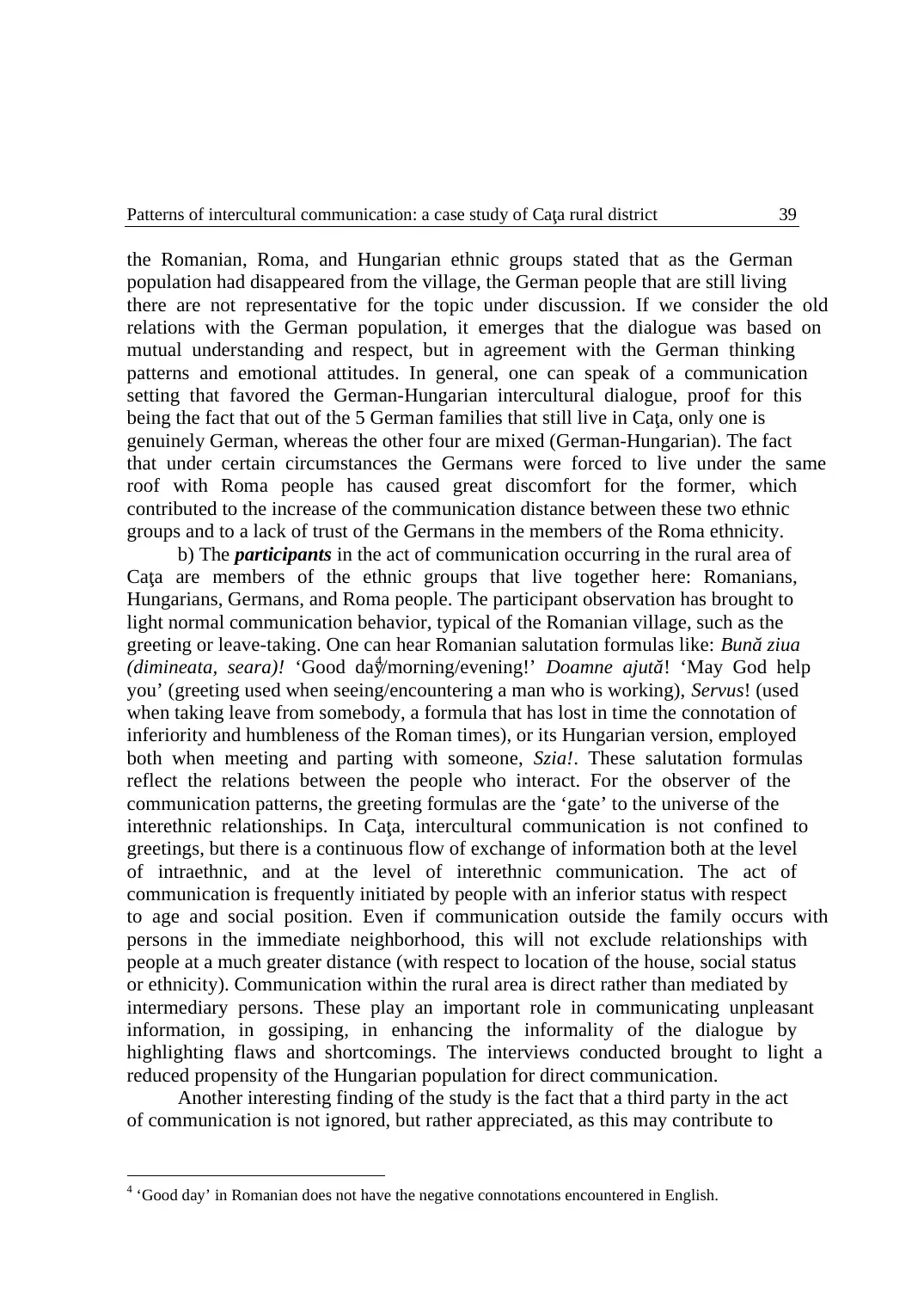
Patterns of intercultural communication: a case study of Caţa rural district 39
the Romanian, Roma, and Hungarian ethnic groups stated that as the German
population had disappeared from the village, the German people that are still living
there are not representative for the topic under discussion. If we consider the old
relations with the German population, it emerges that the dialogue was based on
mutual understanding and respect, but in agreement with the German thinking
patterns and emotional attitudes. In general, one can speak of a communication
setting that favored the German-Hungarian intercultural dialogue, proof for this
being the fact that out of the 5 German families that still live in Caţa, only one is
genuinely German, whereas the other four are mixed (German-Hungarian). The fact
that under certain circumstances the Germans were forced to live under the same
roof with Roma people has caused great discomfort for the former, which
contributed to the increase of the communication distance between these two ethnic
groups and to a lack of trust of the Germans in the members of the Roma ethnicity.
b) The participants in the act of communication occurring in the rural area of
Caţa are members of the ethnic groups that live together here: Romanians,
Hungarians, Germans, and Roma people. The participant observation has brought to
light normal communication behavior, typical of the Romanian village, such as the
greeting or leave-taking. One can hear Romanian salutation formulas like: Bună ziua
(dimineata, seara)! ‘Good day4/morning/evening!’ Doamne ajută! ‘May God help
you’ (greeting used when seeing/encountering a man who is working), Servus! (used
when taking leave from somebody, a formula that has lost in time the connotation of
inferiority and humbleness of the Roman times), or its Hungarian version, employed
both when meeting and parting with someone, Szia!. These salutation formulas
reflect the relations between the people who interact. For the observer of the
communication patterns, the greeting formulas are the ‘gate’ to the universe of the
interethnic relationships. In Caţa, intercultural communication is not confined to
greetings, but there is a continuous flow of exchange of information both at the level
of intraethnic, and at the level of interethnic communication. The act of
communication is frequently initiated by people with an inferior status with respect
to age and social position. Even if communication outside the family occurs with
persons in the immediate neighborhood, this will not exclude relationships with
people at a much greater distance (with respect to location of the house, social status
or ethnicity). Communication within the rural area is direct rather than mediated by
intermediary persons. These play an important role in communicating unpleasant
information, in gossiping, in enhancing the informality of the dialogue by
highlighting flaws and shortcomings. The interviews conducted brought to light a
reduced propensity of the Hungarian population for direct communication.
Another interesting finding of the study is the fact that a third party in the act
of communication is not ignored, but rather appreciated, as this may contribute to
4 ‘Good day’ in Romanian does not have the negative connotations encountered in English.
the Romanian, Roma, and Hungarian ethnic groups stated that as the German
population had disappeared from the village, the German people that are still living
there are not representative for the topic under discussion. If we consider the old
relations with the German population, it emerges that the dialogue was based on
mutual understanding and respect, but in agreement with the German thinking
patterns and emotional attitudes. In general, one can speak of a communication
setting that favored the German-Hungarian intercultural dialogue, proof for this
being the fact that out of the 5 German families that still live in Caţa, only one is
genuinely German, whereas the other four are mixed (German-Hungarian). The fact
that under certain circumstances the Germans were forced to live under the same
roof with Roma people has caused great discomfort for the former, which
contributed to the increase of the communication distance between these two ethnic
groups and to a lack of trust of the Germans in the members of the Roma ethnicity.
b) The participants in the act of communication occurring in the rural area of
Caţa are members of the ethnic groups that live together here: Romanians,
Hungarians, Germans, and Roma people. The participant observation has brought to
light normal communication behavior, typical of the Romanian village, such as the
greeting or leave-taking. One can hear Romanian salutation formulas like: Bună ziua
(dimineata, seara)! ‘Good day4/morning/evening!’ Doamne ajută! ‘May God help
you’ (greeting used when seeing/encountering a man who is working), Servus! (used
when taking leave from somebody, a formula that has lost in time the connotation of
inferiority and humbleness of the Roman times), or its Hungarian version, employed
both when meeting and parting with someone, Szia!. These salutation formulas
reflect the relations between the people who interact. For the observer of the
communication patterns, the greeting formulas are the ‘gate’ to the universe of the
interethnic relationships. In Caţa, intercultural communication is not confined to
greetings, but there is a continuous flow of exchange of information both at the level
of intraethnic, and at the level of interethnic communication. The act of
communication is frequently initiated by people with an inferior status with respect
to age and social position. Even if communication outside the family occurs with
persons in the immediate neighborhood, this will not exclude relationships with
people at a much greater distance (with respect to location of the house, social status
or ethnicity). Communication within the rural area is direct rather than mediated by
intermediary persons. These play an important role in communicating unpleasant
information, in gossiping, in enhancing the informality of the dialogue by
highlighting flaws and shortcomings. The interviews conducted brought to light a
reduced propensity of the Hungarian population for direct communication.
Another interesting finding of the study is the fact that a third party in the act
of communication is not ignored, but rather appreciated, as this may contribute to
4 ‘Good day’ in Romanian does not have the negative connotations encountered in English.
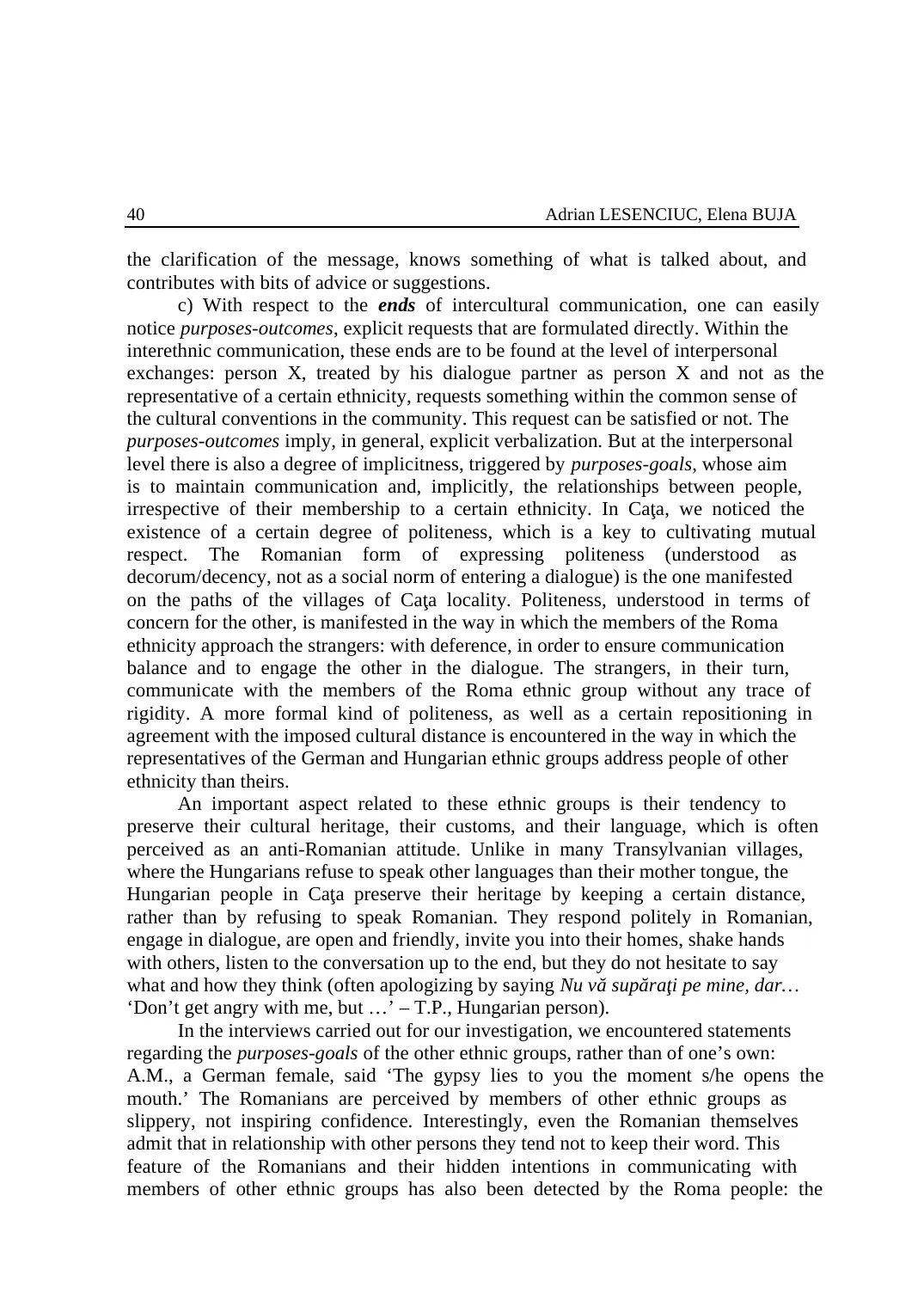
Adrian LESENCIUC, Elena BUJA40
the clarification of the message, knows something of what is talked about, and
contributes with bits of advice or suggestions.
c) With respect to the ends of intercultural communication, one can easily
notice purposes-outcomes, explicit requests that are formulated directly. Within the
interethnic communication, these ends are to be found at the level of interpersonal
exchanges: person X, treated by his dialogue partner as person X and not as the
representative of a certain ethnicity, requests something within the common sense of
the cultural conventions in the community. This request can be satisfied or not. The
purposes-outcomes imply, in general, explicit verbalization. But at the interpersonal
level there is also a degree of implicitness, triggered by purposes-goals, whose aim
is to maintain communication and, implicitly, the relationships between people,
irrespective of their membership to a certain ethnicity. In Caţa, we noticed the
existence of a certain degree of politeness, which is a key to cultivating mutual
respect. The Romanian form of expressing politeness (understood as
decorum/decency, not as a social norm of entering a dialogue) is the one manifested
on the paths of the villages of Caţa locality. Politeness, understood in terms of
concern for the other, is manifested in the way in which the members of the Roma
ethnicity approach the strangers: with deference, in order to ensure communication
balance and to engage the other in the dialogue. The strangers, in their turn,
communicate with the members of the Roma ethnic group without any trace of
rigidity. A more formal kind of politeness, as well as a certain repositioning in
agreement with the imposed cultural distance is encountered in the way in which the
representatives of the German and Hungarian ethnic groups address people of other
ethnicity than theirs.
An important aspect related to these ethnic groups is their tendency to
preserve their cultural heritage, their customs, and their language, which is often
perceived as an anti-Romanian attitude. Unlike in many Transylvanian villages,
where the Hungarians refuse to speak other languages than their mother tongue, the
Hungarian people in Caţa preserve their heritage by keeping a certain distance,
rather than by refusing to speak Romanian. They respond politely in Romanian,
engage in dialogue, are open and friendly, invite you into their homes, shake hands
with others, listen to the conversation up to the end, but they do not hesitate to say
what and how they think (often apologizing by saying Nu vă supăraţi pe mine, dar…
‘Don’t get angry with me, but …’ – T.P., Hungarian person).
In the interviews carried out for our investigation, we encountered statements
regarding the purposes-goals of the other ethnic groups, rather than of one’s own:
A.M., a German female, said ‘The gypsy lies to you the moment s/he opens the
mouth.’ The Romanians are perceived by members of other ethnic groups as
slippery, not inspiring confidence. Interestingly, even the Romanian themselves
admit that in relationship with other persons they tend not to keep their word. This
feature of the Romanians and their hidden intentions in communicating with
members of other ethnic groups has also been detected by the Roma people: the
the clarification of the message, knows something of what is talked about, and
contributes with bits of advice or suggestions.
c) With respect to the ends of intercultural communication, one can easily
notice purposes-outcomes, explicit requests that are formulated directly. Within the
interethnic communication, these ends are to be found at the level of interpersonal
exchanges: person X, treated by his dialogue partner as person X and not as the
representative of a certain ethnicity, requests something within the common sense of
the cultural conventions in the community. This request can be satisfied or not. The
purposes-outcomes imply, in general, explicit verbalization. But at the interpersonal
level there is also a degree of implicitness, triggered by purposes-goals, whose aim
is to maintain communication and, implicitly, the relationships between people,
irrespective of their membership to a certain ethnicity. In Caţa, we noticed the
existence of a certain degree of politeness, which is a key to cultivating mutual
respect. The Romanian form of expressing politeness (understood as
decorum/decency, not as a social norm of entering a dialogue) is the one manifested
on the paths of the villages of Caţa locality. Politeness, understood in terms of
concern for the other, is manifested in the way in which the members of the Roma
ethnicity approach the strangers: with deference, in order to ensure communication
balance and to engage the other in the dialogue. The strangers, in their turn,
communicate with the members of the Roma ethnic group without any trace of
rigidity. A more formal kind of politeness, as well as a certain repositioning in
agreement with the imposed cultural distance is encountered in the way in which the
representatives of the German and Hungarian ethnic groups address people of other
ethnicity than theirs.
An important aspect related to these ethnic groups is their tendency to
preserve their cultural heritage, their customs, and their language, which is often
perceived as an anti-Romanian attitude. Unlike in many Transylvanian villages,
where the Hungarians refuse to speak other languages than their mother tongue, the
Hungarian people in Caţa preserve their heritage by keeping a certain distance,
rather than by refusing to speak Romanian. They respond politely in Romanian,
engage in dialogue, are open and friendly, invite you into their homes, shake hands
with others, listen to the conversation up to the end, but they do not hesitate to say
what and how they think (often apologizing by saying Nu vă supăraţi pe mine, dar…
‘Don’t get angry with me, but …’ – T.P., Hungarian person).
In the interviews carried out for our investigation, we encountered statements
regarding the purposes-goals of the other ethnic groups, rather than of one’s own:
A.M., a German female, said ‘The gypsy lies to you the moment s/he opens the
mouth.’ The Romanians are perceived by members of other ethnic groups as
slippery, not inspiring confidence. Interestingly, even the Romanian themselves
admit that in relationship with other persons they tend not to keep their word. This
feature of the Romanians and their hidden intentions in communicating with
members of other ethnic groups has also been detected by the Roma people: the
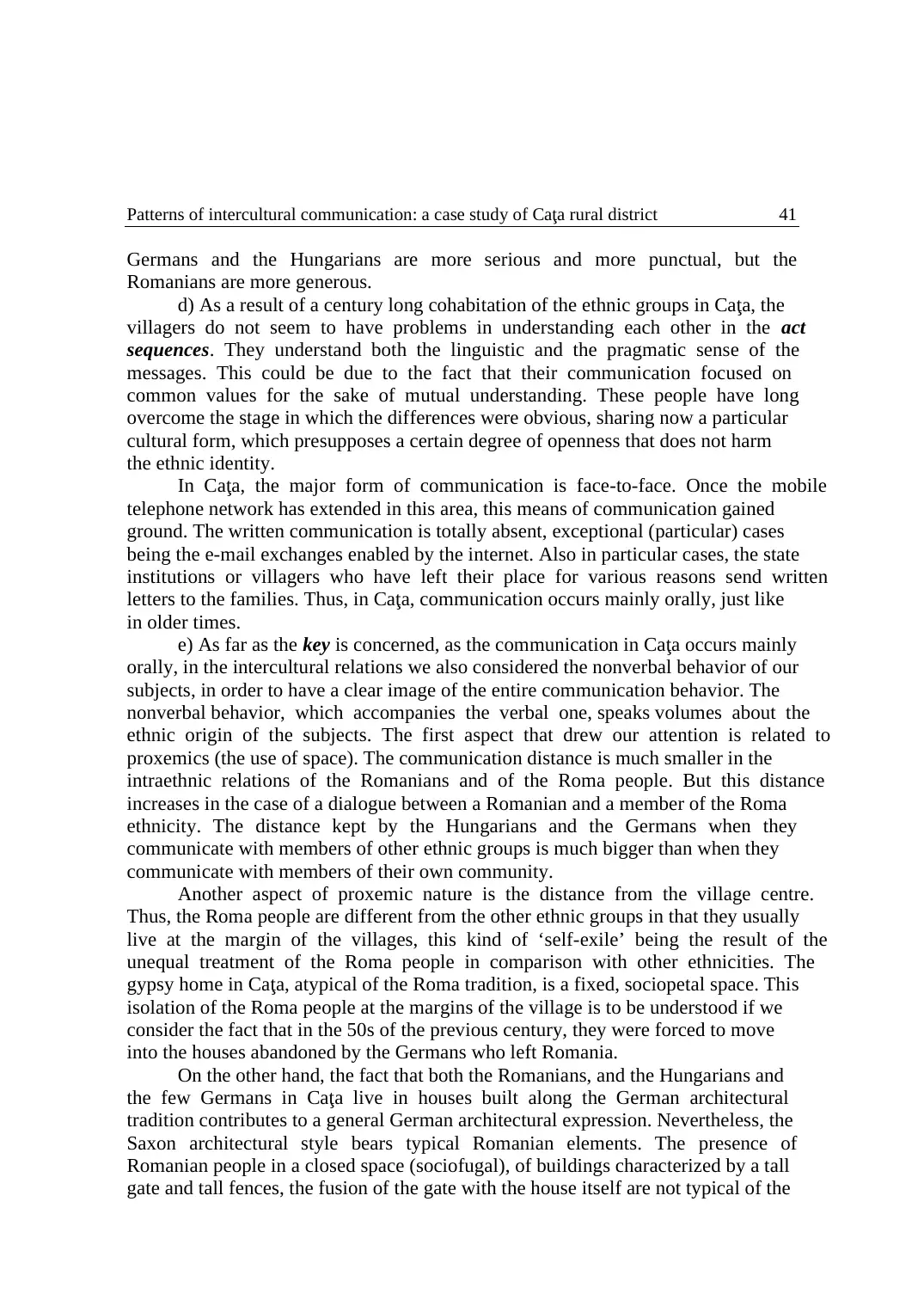
Patterns of intercultural communication: a case study of Caţa rural district 41
Germans and the Hungarians are more serious and more punctual, but the
Romanians are more generous.
d) As a result of a century long cohabitation of the ethnic groups in Caţa, the
villagers do not seem to have problems in understanding each other in the act
sequences. They understand both the linguistic and the pragmatic sense of the
messages. This could be due to the fact that their communication focused on
common values for the sake of mutual understanding. These people have long
overcome the stage in which the differences were obvious, sharing now a particular
cultural form, which presupposes a certain degree of openness that does not harm
the ethnic identity.
In Caţa, the major form of communication is face-to-face. Once the mobile
telephone network has extended in this area, this means of communication gained
ground. The written communication is totally absent, exceptional (particular) cases
being the e-mail exchanges enabled by the internet. Also in particular cases, the state
institutions or villagers who have left their place for various reasons send written
letters to the families. Thus, in Caţa, communication occurs mainly orally, just like
in older times.
e) As far as the key is concerned, as the communication in Caţa occurs mainly
orally, in the intercultural relations we also considered the nonverbal behavior of our
subjects, in order to have a clear image of the entire communication behavior. The
nonverbal behavior, which accompanies the verbal one, speaks volumes about the
ethnic origin of the subjects. The first aspect that drew our attention is related to
proxemics (the use of space). The communication distance is much smaller in the
intraethnic relations of the Romanians and of the Roma people. But this distance
increases in the case of a dialogue between a Romanian and a member of the Roma
ethnicity. The distance kept by the Hungarians and the Germans when they
communicate with members of other ethnic groups is much bigger than when they
communicate with members of their own community.
Another aspect of proxemic nature is the distance from the village centre.
Thus, the Roma people are different from the other ethnic groups in that they usually
live at the margin of the villages, this kind of ‘self-exile’ being the result of the
unequal treatment of the Roma people in comparison with other ethnicities. The
gypsy home in Caţa, atypical of the Roma tradition, is a fixed, sociopetal space. This
isolation of the Roma people at the margins of the village is to be understood if we
consider the fact that in the 50s of the previous century, they were forced to move
into the houses abandoned by the Germans who left Romania.
On the other hand, the fact that both the Romanians, and the Hungarians and
the few Germans in Caţa live in houses built along the German architectural
tradition contributes to a general German architectural expression. Nevertheless, the
Saxon architectural style bears typical Romanian elements. The presence of
Romanian people in a closed space (sociofugal), of buildings characterized by a tall
gate and tall fences, the fusion of the gate with the house itself are not typical of the
Germans and the Hungarians are more serious and more punctual, but the
Romanians are more generous.
d) As a result of a century long cohabitation of the ethnic groups in Caţa, the
villagers do not seem to have problems in understanding each other in the act
sequences. They understand both the linguistic and the pragmatic sense of the
messages. This could be due to the fact that their communication focused on
common values for the sake of mutual understanding. These people have long
overcome the stage in which the differences were obvious, sharing now a particular
cultural form, which presupposes a certain degree of openness that does not harm
the ethnic identity.
In Caţa, the major form of communication is face-to-face. Once the mobile
telephone network has extended in this area, this means of communication gained
ground. The written communication is totally absent, exceptional (particular) cases
being the e-mail exchanges enabled by the internet. Also in particular cases, the state
institutions or villagers who have left their place for various reasons send written
letters to the families. Thus, in Caţa, communication occurs mainly orally, just like
in older times.
e) As far as the key is concerned, as the communication in Caţa occurs mainly
orally, in the intercultural relations we also considered the nonverbal behavior of our
subjects, in order to have a clear image of the entire communication behavior. The
nonverbal behavior, which accompanies the verbal one, speaks volumes about the
ethnic origin of the subjects. The first aspect that drew our attention is related to
proxemics (the use of space). The communication distance is much smaller in the
intraethnic relations of the Romanians and of the Roma people. But this distance
increases in the case of a dialogue between a Romanian and a member of the Roma
ethnicity. The distance kept by the Hungarians and the Germans when they
communicate with members of other ethnic groups is much bigger than when they
communicate with members of their own community.
Another aspect of proxemic nature is the distance from the village centre.
Thus, the Roma people are different from the other ethnic groups in that they usually
live at the margin of the villages, this kind of ‘self-exile’ being the result of the
unequal treatment of the Roma people in comparison with other ethnicities. The
gypsy home in Caţa, atypical of the Roma tradition, is a fixed, sociopetal space. This
isolation of the Roma people at the margins of the village is to be understood if we
consider the fact that in the 50s of the previous century, they were forced to move
into the houses abandoned by the Germans who left Romania.
On the other hand, the fact that both the Romanians, and the Hungarians and
the few Germans in Caţa live in houses built along the German architectural
tradition contributes to a general German architectural expression. Nevertheless, the
Saxon architectural style bears typical Romanian elements. The presence of
Romanian people in a closed space (sociofugal), of buildings characterized by a tall
gate and tall fences, the fusion of the gate with the house itself are not typical of the
Paraphrase This Document
Need a fresh take? Get an instant paraphrase of this document with our AI Paraphraser
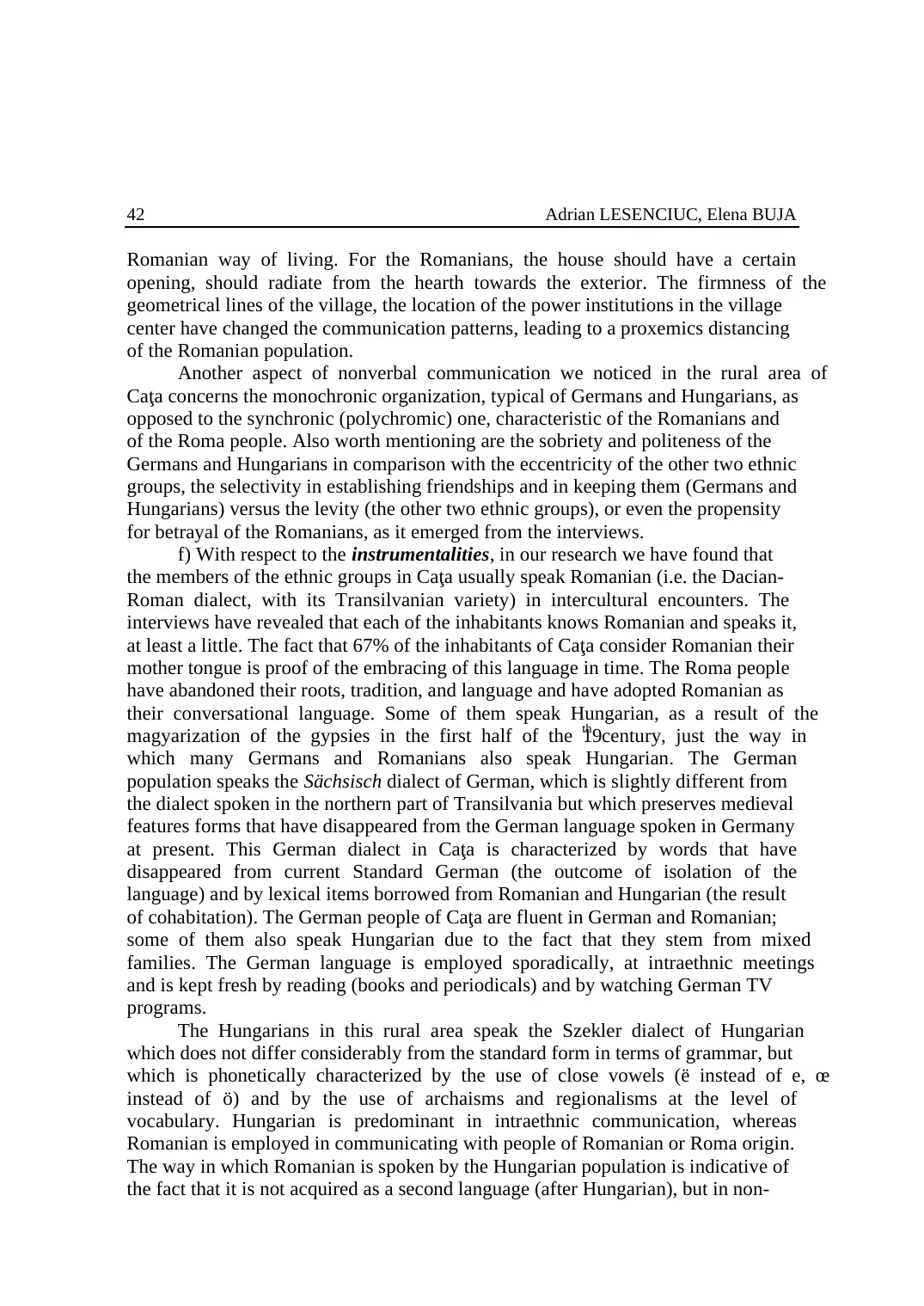
Adrian LESENCIUC, Elena BUJA42
Romanian way of living. For the Romanians, the house should have a certain
opening, should radiate from the hearth towards the exterior. The firmness of the
geometrical lines of the village, the location of the power institutions in the village
center have changed the communication patterns, leading to a proxemics distancing
of the Romanian population.
Another aspect of nonverbal communication we noticed in the rural area of
Caţa concerns the monochronic organization, typical of Germans and Hungarians, as
opposed to the synchronic (polychromic) one, characteristic of the Romanians and
of the Roma people. Also worth mentioning are the sobriety and politeness of the
Germans and Hungarians in comparison with the eccentricity of the other two ethnic
groups, the selectivity in establishing friendships and in keeping them (Germans and
Hungarians) versus the levity (the other two ethnic groups), or even the propensity
for betrayal of the Romanians, as it emerged from the interviews.
f) With respect to the instrumentalities, in our research we have found that
the members of the ethnic groups in Caţa usually speak Romanian (i.e. the Dacian-
Roman dialect, with its Transilvanian variety) in intercultural encounters. The
interviews have revealed that each of the inhabitants knows Romanian and speaks it,
at least a little. The fact that 67% of the inhabitants of Caţa consider Romanian their
mother tongue is proof of the embracing of this language in time. The Roma people
have abandoned their roots, tradition, and language and have adopted Romanian as
their conversational language. Some of them speak Hungarian, as a result of the
magyarization of the gypsies in the first half of the 19th century, just the way in
which many Germans and Romanians also speak Hungarian. The German
population speaks the Sächsisch dialect of German, which is slightly different from
the dialect spoken in the northern part of Transilvania but which preserves medieval
features forms that have disappeared from the German language spoken in Germany
at present. This German dialect in Caţa is characterized by words that have
disappeared from current Standard German (the outcome of isolation of the
language) and by lexical items borrowed from Romanian and Hungarian (the result
of cohabitation). The German people of Caţa are fluent in German and Romanian;
some of them also speak Hungarian due to the fact that they stem from mixed
families. The German language is employed sporadically, at intraethnic meetings
and is kept fresh by reading (books and periodicals) and by watching German TV
programs.
The Hungarians in this rural area speak the Szekler dialect of Hungarian
which does not differ considerably from the standard form in terms of grammar, but
which is phonetically characterized by the use of close vowels (ë instead of e, œ
instead of ö) and by the use of archaisms and regionalisms at the level of
vocabulary. Hungarian is predominant in intraethnic communication, whereas
Romanian is employed in communicating with people of Romanian or Roma origin.
The way in which Romanian is spoken by the Hungarian population is indicative of
the fact that it is not acquired as a second language (after Hungarian), but in non-
Romanian way of living. For the Romanians, the house should have a certain
opening, should radiate from the hearth towards the exterior. The firmness of the
geometrical lines of the village, the location of the power institutions in the village
center have changed the communication patterns, leading to a proxemics distancing
of the Romanian population.
Another aspect of nonverbal communication we noticed in the rural area of
Caţa concerns the monochronic organization, typical of Germans and Hungarians, as
opposed to the synchronic (polychromic) one, characteristic of the Romanians and
of the Roma people. Also worth mentioning are the sobriety and politeness of the
Germans and Hungarians in comparison with the eccentricity of the other two ethnic
groups, the selectivity in establishing friendships and in keeping them (Germans and
Hungarians) versus the levity (the other two ethnic groups), or even the propensity
for betrayal of the Romanians, as it emerged from the interviews.
f) With respect to the instrumentalities, in our research we have found that
the members of the ethnic groups in Caţa usually speak Romanian (i.e. the Dacian-
Roman dialect, with its Transilvanian variety) in intercultural encounters. The
interviews have revealed that each of the inhabitants knows Romanian and speaks it,
at least a little. The fact that 67% of the inhabitants of Caţa consider Romanian their
mother tongue is proof of the embracing of this language in time. The Roma people
have abandoned their roots, tradition, and language and have adopted Romanian as
their conversational language. Some of them speak Hungarian, as a result of the
magyarization of the gypsies in the first half of the 19th century, just the way in
which many Germans and Romanians also speak Hungarian. The German
population speaks the Sächsisch dialect of German, which is slightly different from
the dialect spoken in the northern part of Transilvania but which preserves medieval
features forms that have disappeared from the German language spoken in Germany
at present. This German dialect in Caţa is characterized by words that have
disappeared from current Standard German (the outcome of isolation of the
language) and by lexical items borrowed from Romanian and Hungarian (the result
of cohabitation). The German people of Caţa are fluent in German and Romanian;
some of them also speak Hungarian due to the fact that they stem from mixed
families. The German language is employed sporadically, at intraethnic meetings
and is kept fresh by reading (books and periodicals) and by watching German TV
programs.
The Hungarians in this rural area speak the Szekler dialect of Hungarian
which does not differ considerably from the standard form in terms of grammar, but
which is phonetically characterized by the use of close vowels (ë instead of e, œ
instead of ö) and by the use of archaisms and regionalisms at the level of
vocabulary. Hungarian is predominant in intraethnic communication, whereas
Romanian is employed in communicating with people of Romanian or Roma origin.
The way in which Romanian is spoken by the Hungarian population is indicative of
the fact that it is not acquired as a second language (after Hungarian), but in non-
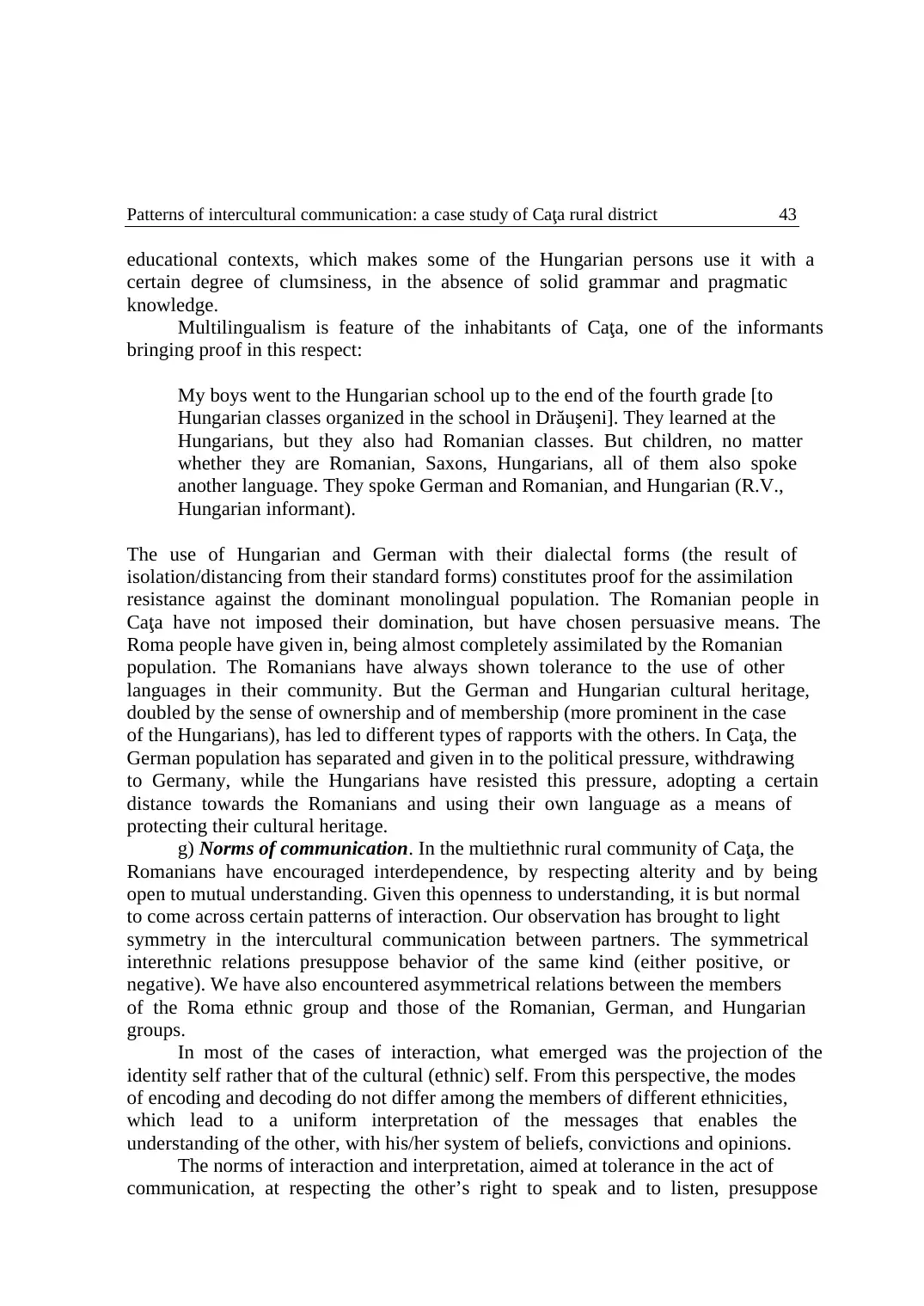
Patterns of intercultural communication: a case study of Caţa rural district 43
educational contexts, which makes some of the Hungarian persons use it with a
certain degree of clumsiness, in the absence of solid grammar and pragmatic
knowledge.
Multilingualism is feature of the inhabitants of Caţa, one of the informants
bringing proof in this respect:
My boys went to the Hungarian school up to the end of the fourth grade [to
Hungarian classes organized in the school in Drăuşeni]. They learned at the
Hungarians, but they also had Romanian classes. But children, no matter
whether they are Romanian, Saxons, Hungarians, all of them also spoke
another language. They spoke German and Romanian, and Hungarian (R.V.,
Hungarian informant).
The use of Hungarian and German with their dialectal forms (the result of
isolation/distancing from their standard forms) constitutes proof for the assimilation
resistance against the dominant monolingual population. The Romanian people in
Caţa have not imposed their domination, but have chosen persuasive means. The
Roma people have given in, being almost completely assimilated by the Romanian
population. The Romanians have always shown tolerance to the use of other
languages in their community. But the German and Hungarian cultural heritage,
doubled by the sense of ownership and of membership (more prominent in the case
of the Hungarians), has led to different types of rapports with the others. In Caţa, the
German population has separated and given in to the political pressure, withdrawing
to Germany, while the Hungarians have resisted this pressure, adopting a certain
distance towards the Romanians and using their own language as a means of
protecting their cultural heritage.
g) Norms of communication. In the multiethnic rural community of Caţa, the
Romanians have encouraged interdependence, by respecting alterity and by being
open to mutual understanding. Given this openness to understanding, it is but normal
to come across certain patterns of interaction. Our observation has brought to light
symmetry in the intercultural communication between partners. The symmetrical
interethnic relations presuppose behavior of the same kind (either positive, or
negative). We have also encountered asymmetrical relations between the members
of the Roma ethnic group and those of the Romanian, German, and Hungarian
groups.
In most of the cases of interaction, what emerged was the projection of the
identity self rather that of the cultural (ethnic) self. From this perspective, the modes
of encoding and decoding do not differ among the members of different ethnicities,
which lead to a uniform interpretation of the messages that enables the
understanding of the other, with his/her system of beliefs, convictions and opinions.
The norms of interaction and interpretation, aimed at tolerance in the act of
communication, at respecting the other’s right to speak and to listen, presuppose
educational contexts, which makes some of the Hungarian persons use it with a
certain degree of clumsiness, in the absence of solid grammar and pragmatic
knowledge.
Multilingualism is feature of the inhabitants of Caţa, one of the informants
bringing proof in this respect:
My boys went to the Hungarian school up to the end of the fourth grade [to
Hungarian classes organized in the school in Drăuşeni]. They learned at the
Hungarians, but they also had Romanian classes. But children, no matter
whether they are Romanian, Saxons, Hungarians, all of them also spoke
another language. They spoke German and Romanian, and Hungarian (R.V.,
Hungarian informant).
The use of Hungarian and German with their dialectal forms (the result of
isolation/distancing from their standard forms) constitutes proof for the assimilation
resistance against the dominant monolingual population. The Romanian people in
Caţa have not imposed their domination, but have chosen persuasive means. The
Roma people have given in, being almost completely assimilated by the Romanian
population. The Romanians have always shown tolerance to the use of other
languages in their community. But the German and Hungarian cultural heritage,
doubled by the sense of ownership and of membership (more prominent in the case
of the Hungarians), has led to different types of rapports with the others. In Caţa, the
German population has separated and given in to the political pressure, withdrawing
to Germany, while the Hungarians have resisted this pressure, adopting a certain
distance towards the Romanians and using their own language as a means of
protecting their cultural heritage.
g) Norms of communication. In the multiethnic rural community of Caţa, the
Romanians have encouraged interdependence, by respecting alterity and by being
open to mutual understanding. Given this openness to understanding, it is but normal
to come across certain patterns of interaction. Our observation has brought to light
symmetry in the intercultural communication between partners. The symmetrical
interethnic relations presuppose behavior of the same kind (either positive, or
negative). We have also encountered asymmetrical relations between the members
of the Roma ethnic group and those of the Romanian, German, and Hungarian
groups.
In most of the cases of interaction, what emerged was the projection of the
identity self rather that of the cultural (ethnic) self. From this perspective, the modes
of encoding and decoding do not differ among the members of different ethnicities,
which lead to a uniform interpretation of the messages that enables the
understanding of the other, with his/her system of beliefs, convictions and opinions.
The norms of interaction and interpretation, aimed at tolerance in the act of
communication, at respecting the other’s right to speak and to listen, presuppose
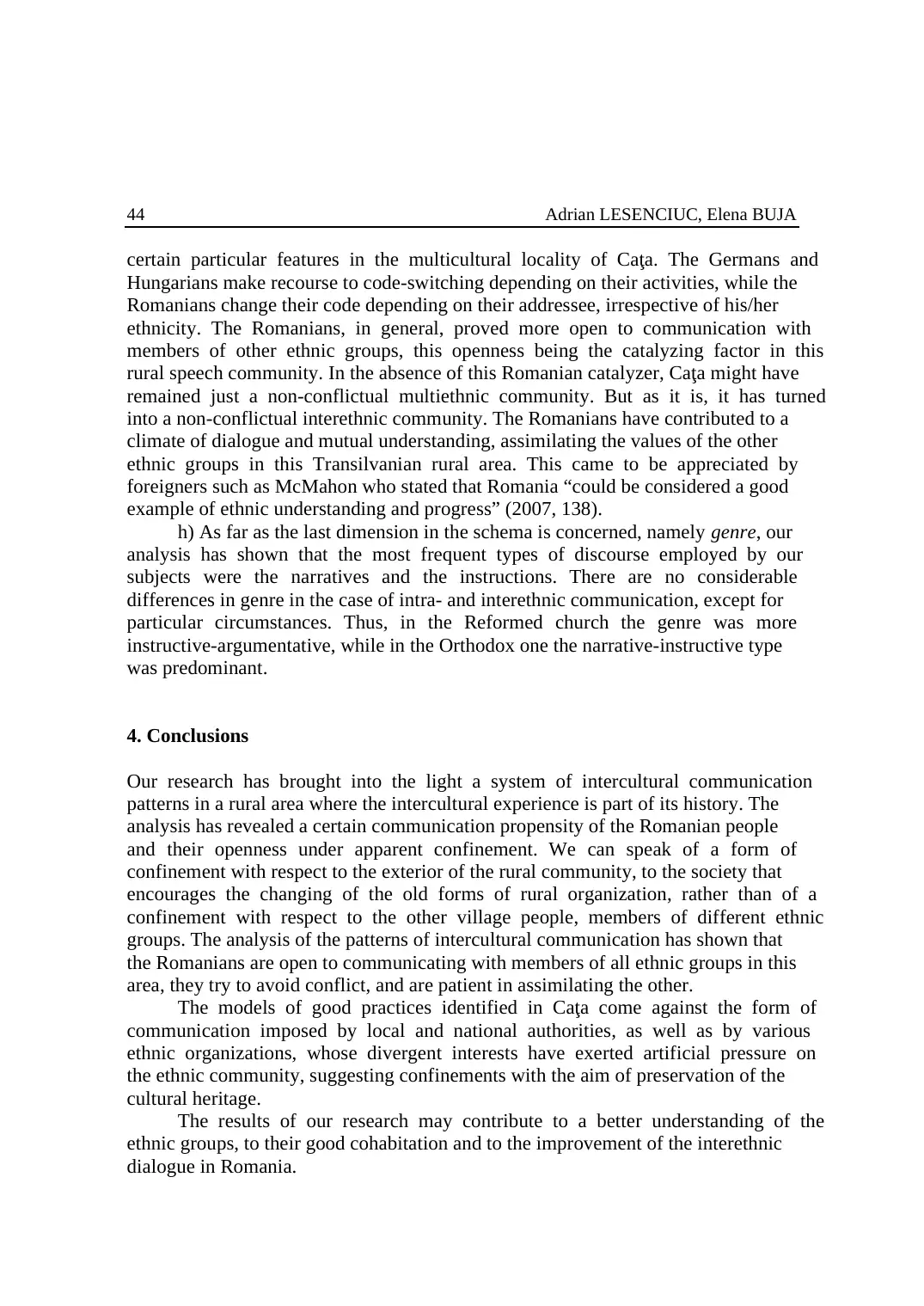
Adrian LESENCIUC, Elena BUJA44
certain particular features in the multicultural locality of Caţa. The Germans and
Hungarians make recourse to code-switching depending on their activities, while the
Romanians change their code depending on their addressee, irrespective of his/her
ethnicity. The Romanians, in general, proved more open to communication with
members of other ethnic groups, this openness being the catalyzing factor in this
rural speech community. In the absence of this Romanian catalyzer, Caţa might have
remained just a non-conflictual multiethnic community. But as it is, it has turned
into a non-conflictual interethnic community. The Romanians have contributed to a
climate of dialogue and mutual understanding, assimilating the values of the other
ethnic groups in this Transilvanian rural area. This came to be appreciated by
foreigners such as McMahon who stated that Romania “could be considered a good
example of ethnic understanding and progress” (2007, 138).
h) As far as the last dimension in the schema is concerned, namely genre, our
analysis has shown that the most frequent types of discourse employed by our
subjects were the narratives and the instructions. There are no considerable
differences in genre in the case of intra- and interethnic communication, except for
particular circumstances. Thus, in the Reformed church the genre was more
instructive-argumentative, while in the Orthodox one the narrative-instructive type
was predominant.
4. Conclusions
Our research has brought into the light a system of intercultural communication
patterns in a rural area where the intercultural experience is part of its history. The
analysis has revealed a certain communication propensity of the Romanian people
and their openness under apparent confinement. We can speak of a form of
confinement with respect to the exterior of the rural community, to the society that
encourages the changing of the old forms of rural organization, rather than of a
confinement with respect to the other village people, members of different ethnic
groups. The analysis of the patterns of intercultural communication has shown that
the Romanians are open to communicating with members of all ethnic groups in this
area, they try to avoid conflict, and are patient in assimilating the other.
The models of good practices identified in Caţa come against the form of
communication imposed by local and national authorities, as well as by various
ethnic organizations, whose divergent interests have exerted artificial pressure on
the ethnic community, suggesting confinements with the aim of preservation of the
cultural heritage.
The results of our research may contribute to a better understanding of the
ethnic groups, to their good cohabitation and to the improvement of the interethnic
dialogue in Romania.
certain particular features in the multicultural locality of Caţa. The Germans and
Hungarians make recourse to code-switching depending on their activities, while the
Romanians change their code depending on their addressee, irrespective of his/her
ethnicity. The Romanians, in general, proved more open to communication with
members of other ethnic groups, this openness being the catalyzing factor in this
rural speech community. In the absence of this Romanian catalyzer, Caţa might have
remained just a non-conflictual multiethnic community. But as it is, it has turned
into a non-conflictual interethnic community. The Romanians have contributed to a
climate of dialogue and mutual understanding, assimilating the values of the other
ethnic groups in this Transilvanian rural area. This came to be appreciated by
foreigners such as McMahon who stated that Romania “could be considered a good
example of ethnic understanding and progress” (2007, 138).
h) As far as the last dimension in the schema is concerned, namely genre, our
analysis has shown that the most frequent types of discourse employed by our
subjects were the narratives and the instructions. There are no considerable
differences in genre in the case of intra- and interethnic communication, except for
particular circumstances. Thus, in the Reformed church the genre was more
instructive-argumentative, while in the Orthodox one the narrative-instructive type
was predominant.
4. Conclusions
Our research has brought into the light a system of intercultural communication
patterns in a rural area where the intercultural experience is part of its history. The
analysis has revealed a certain communication propensity of the Romanian people
and their openness under apparent confinement. We can speak of a form of
confinement with respect to the exterior of the rural community, to the society that
encourages the changing of the old forms of rural organization, rather than of a
confinement with respect to the other village people, members of different ethnic
groups. The analysis of the patterns of intercultural communication has shown that
the Romanians are open to communicating with members of all ethnic groups in this
area, they try to avoid conflict, and are patient in assimilating the other.
The models of good practices identified in Caţa come against the form of
communication imposed by local and national authorities, as well as by various
ethnic organizations, whose divergent interests have exerted artificial pressure on
the ethnic community, suggesting confinements with the aim of preservation of the
cultural heritage.
The results of our research may contribute to a better understanding of the
ethnic groups, to their good cohabitation and to the improvement of the interethnic
dialogue in Romania.
Secure Best Marks with AI Grader
Need help grading? Try our AI Grader for instant feedback on your assignments.
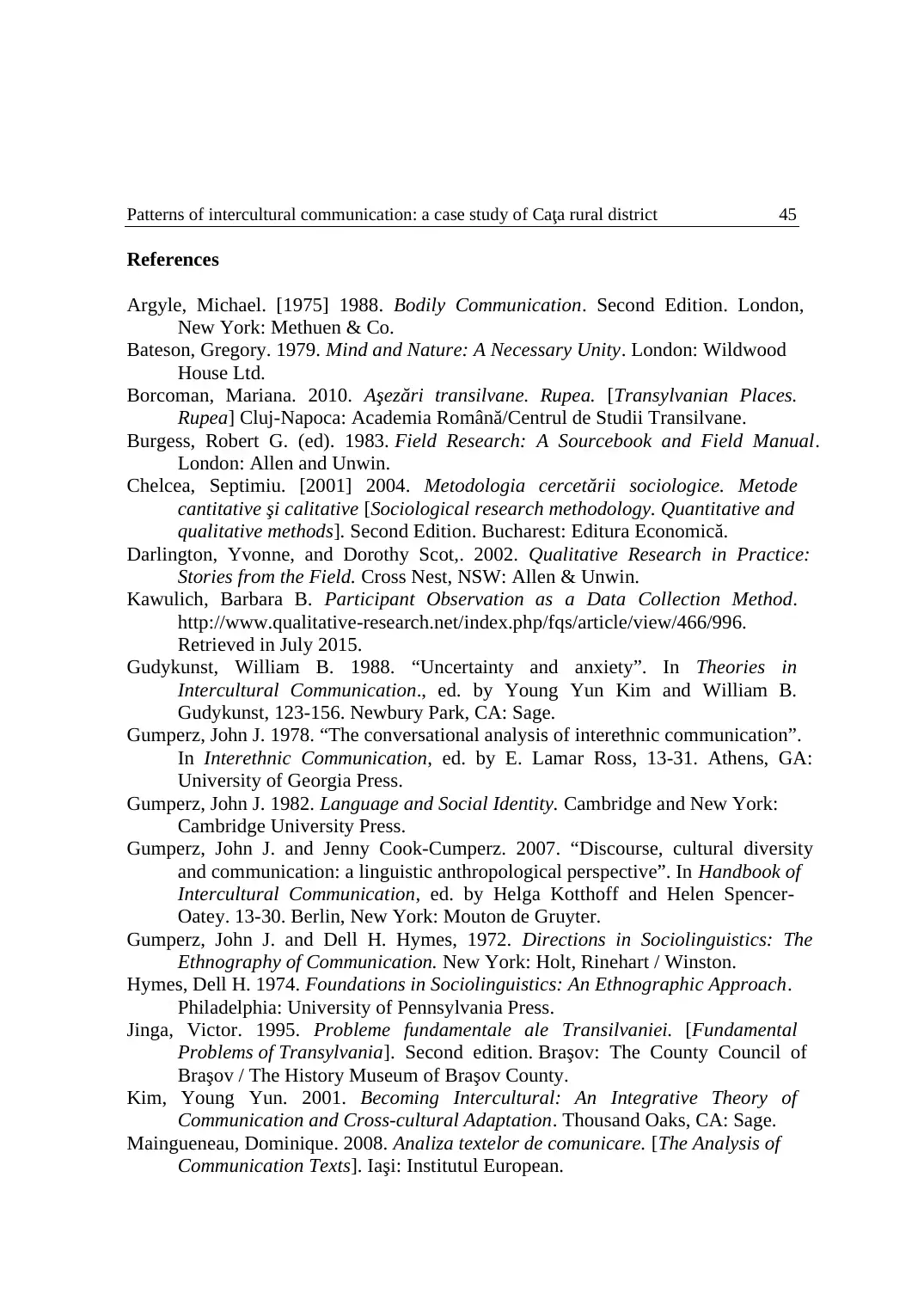
Patterns of intercultural communication: a case study of Caţa rural district 45
References
Argyle, Michael. [1975] 1988. Bodily Communication. Second Edition. London,
New York: Methuen & Co.
Bateson, Gregory. 1979. Mind and Nature: A Necessary Unity. London: Wildwood
House Ltd.
Borcoman, Mariana. 2010. Aşezări transilvane. Rupea. [Transylvanian Places.
Rupea] Cluj-Napoca: Academia Română/Centrul de Studii Transilvane.
Burgess, Robert G. (ed). 1983. Field Research: A Sourcebook and Field Manual.
London: Allen and Unwin.
Chelcea, Septimiu. [2001] 2004. Metodologia cercetării sociologice. Metode
cantitative şi calitative [Sociological research methodology. Quantitative and
qualitative methods]. Second Edition. Bucharest: Editura Economică.
Darlington, Yvonne, and Dorothy Scot,. 2002. Qualitative Research in Practice:
Stories from the Field. Cross Nest, NSW: Allen & Unwin.
Kawulich, Barbara B. Participant Observation as a Data Collection Method.
http://www.qualitative-research.net/index.php/fqs/article/view/466/996.
Retrieved in July 2015.
Gudykunst, William B. 1988. “Uncertainty and anxiety”. In Theories in
Intercultural Communication., ed. by Young Yun Kim and William B.
Gudykunst, 123-156. Newbury Park, CA: Sage.
Gumperz, John J. 1978. “The conversational analysis of interethnic communication”.
In Interethnic Communication, ed. by E. Lamar Ross, 13-31. Athens, GA:
University of Georgia Press.
Gumperz, John J. 1982. Language and Social Identity. Cambridge and New York:
Cambridge University Press.
Gumperz, John J. and Jenny Cook-Cumperz. 2007. “Discourse, cultural diversity
and communication: a linguistic anthropological perspective”. In Handbook of
Intercultural Communication, ed. by Helga Kotthoff and Helen Spencer-
Oatey. 13-30. Berlin, New York: Mouton de Gruyter.
Gumperz, John J. and Dell H. Hymes, 1972. Directions in Sociolinguistics: The
Ethnography of Communication. New York: Holt, Rinehart / Winston.
Hymes, Dell H. 1974. Foundations in Sociolinguistics: An Ethnographic Approach.
Philadelphia: University of Pennsylvania Press.
Jinga, Victor. 1995. Probleme fundamentale ale Transilvaniei. [Fundamental
Problems of Transylvania]. Second edition. Braşov: The County Council of
Braşov / The History Museum of Braşov County.
Kim, Young Yun. 2001. Becoming Intercultural: An Integrative Theory of
Communication and Cross-cultural Adaptation. Thousand Oaks, CA: Sage.
Maingueneau, Dominique. 2008. Analiza textelor de comunicare. [The Analysis of
Communication Texts]. Iaşi: Institutul European.
References
Argyle, Michael. [1975] 1988. Bodily Communication. Second Edition. London,
New York: Methuen & Co.
Bateson, Gregory. 1979. Mind and Nature: A Necessary Unity. London: Wildwood
House Ltd.
Borcoman, Mariana. 2010. Aşezări transilvane. Rupea. [Transylvanian Places.
Rupea] Cluj-Napoca: Academia Română/Centrul de Studii Transilvane.
Burgess, Robert G. (ed). 1983. Field Research: A Sourcebook and Field Manual.
London: Allen and Unwin.
Chelcea, Septimiu. [2001] 2004. Metodologia cercetării sociologice. Metode
cantitative şi calitative [Sociological research methodology. Quantitative and
qualitative methods]. Second Edition. Bucharest: Editura Economică.
Darlington, Yvonne, and Dorothy Scot,. 2002. Qualitative Research in Practice:
Stories from the Field. Cross Nest, NSW: Allen & Unwin.
Kawulich, Barbara B. Participant Observation as a Data Collection Method.
http://www.qualitative-research.net/index.php/fqs/article/view/466/996.
Retrieved in July 2015.
Gudykunst, William B. 1988. “Uncertainty and anxiety”. In Theories in
Intercultural Communication., ed. by Young Yun Kim and William B.
Gudykunst, 123-156. Newbury Park, CA: Sage.
Gumperz, John J. 1978. “The conversational analysis of interethnic communication”.
In Interethnic Communication, ed. by E. Lamar Ross, 13-31. Athens, GA:
University of Georgia Press.
Gumperz, John J. 1982. Language and Social Identity. Cambridge and New York:
Cambridge University Press.
Gumperz, John J. and Jenny Cook-Cumperz. 2007. “Discourse, cultural diversity
and communication: a linguistic anthropological perspective”. In Handbook of
Intercultural Communication, ed. by Helga Kotthoff and Helen Spencer-
Oatey. 13-30. Berlin, New York: Mouton de Gruyter.
Gumperz, John J. and Dell H. Hymes, 1972. Directions in Sociolinguistics: The
Ethnography of Communication. New York: Holt, Rinehart / Winston.
Hymes, Dell H. 1974. Foundations in Sociolinguistics: An Ethnographic Approach.
Philadelphia: University of Pennsylvania Press.
Jinga, Victor. 1995. Probleme fundamentale ale Transilvaniei. [Fundamental
Problems of Transylvania]. Second edition. Braşov: The County Council of
Braşov / The History Museum of Braşov County.
Kim, Young Yun. 2001. Becoming Intercultural: An Integrative Theory of
Communication and Cross-cultural Adaptation. Thousand Oaks, CA: Sage.
Maingueneau, Dominique. 2008. Analiza textelor de comunicare. [The Analysis of
Communication Texts]. Iaşi: Institutul European.
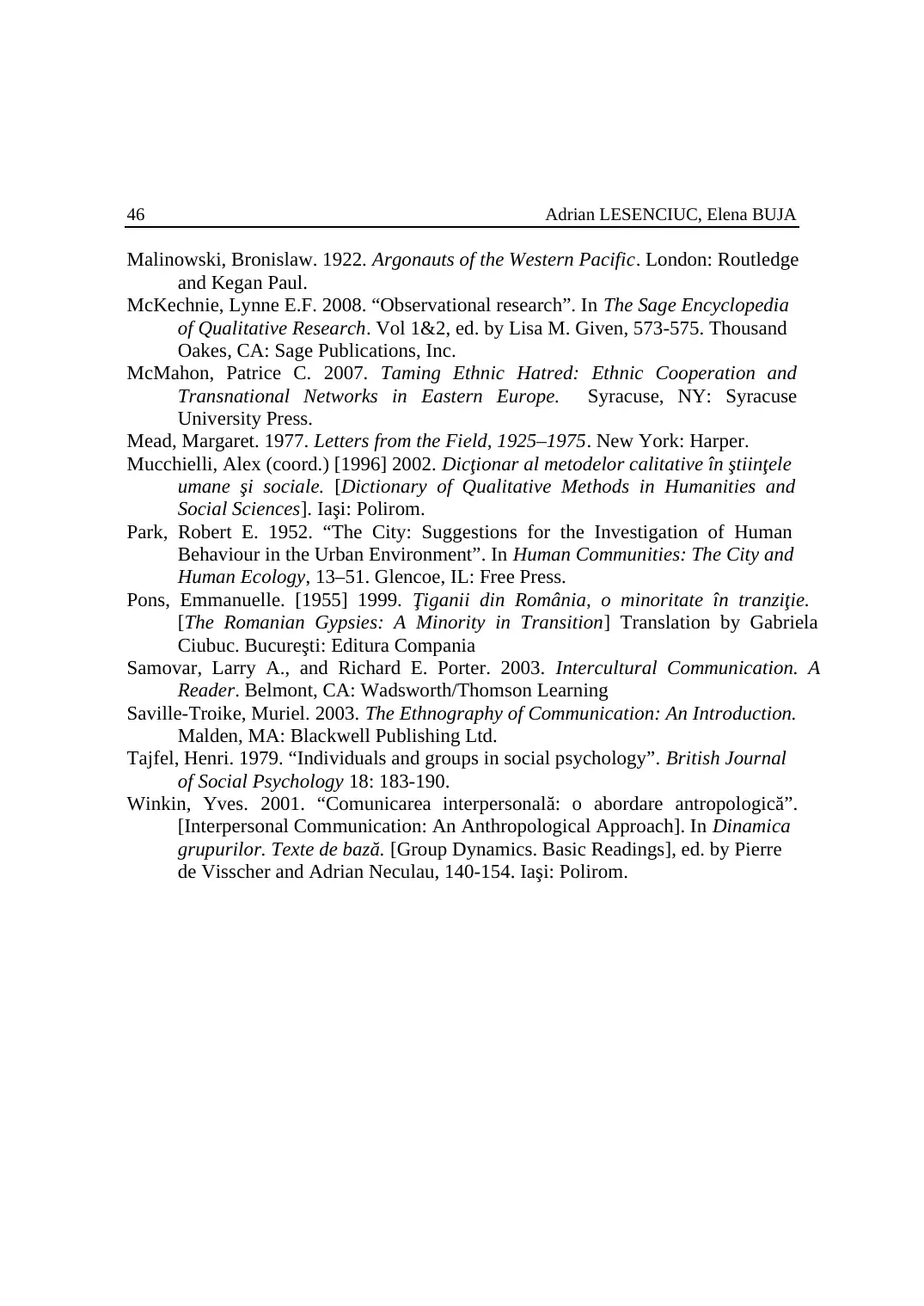
Adrian LESENCIUC, Elena BUJA46
Malinowski, Bronislaw. 1922. Argonauts of the Western Pacific. London: Routledge
and Kegan Paul.
McKechnie, Lynne E.F. 2008. “Observational research”. In The Sage Encyclopedia
of Qualitative Research. Vol 1&2, ed. by Lisa M. Given, 573-575. Thousand
Oakes, CA: Sage Publications, Inc.
McMahon, Patrice C. 2007. Taming Ethnic Hatred: Ethnic Cooperation and
Transnational Networks in Eastern Europe. Syracuse, NY: Syracuse
University Press.
Mead, Margaret. 1977. Letters from the Field, 1925–1975. New York: Harper.
Mucchielli, Alex (coord.) [1996] 2002. Dicţionar al metodelor calitative în ştiinţele
umane şi sociale. [Dictionary of Qualitative Methods in Humanities and
Social Sciences]. Iaşi: Polirom.
Park, Robert E. 1952. “The City: Suggestions for the Investigation of Human
Behaviour in the Urban Environment”. In Human Communities: The City and
Human Ecology, 13–51. Glencoe, IL: Free Press.
Pons, Emmanuelle. [1955] 1999. Ţiganii din România, o minoritate în tranziţie.
[The Romanian Gypsies: A Minority in Transition] Translation by Gabriela
Ciubuc. Bucureşti: Editura Compania
Samovar, Larry A., and Richard E. Porter. 2003. Intercultural Communication. A
Reader. Belmont, CA: Wadsworth/Thomson Learning
Saville-Troike, Muriel. 2003. The Ethnography of Communication: An Introduction.
Malden, MA: Blackwell Publishing Ltd.
Tajfel, Henri. 1979. “Individuals and groups in social psychology”. British Journal
of Social Psychology 18: 183-190.
Winkin, Yves. 2001. “Comunicarea interpersonală: o abordare antropologică”.
[Interpersonal Communication: An Anthropological Approach]. In Dinamica
grupurilor. Texte de bază. [Group Dynamics. Basic Readings], ed. by Pierre
de Visscher and Adrian Neculau, 140-154. Iaşi: Polirom.
Malinowski, Bronislaw. 1922. Argonauts of the Western Pacific. London: Routledge
and Kegan Paul.
McKechnie, Lynne E.F. 2008. “Observational research”. In The Sage Encyclopedia
of Qualitative Research. Vol 1&2, ed. by Lisa M. Given, 573-575. Thousand
Oakes, CA: Sage Publications, Inc.
McMahon, Patrice C. 2007. Taming Ethnic Hatred: Ethnic Cooperation and
Transnational Networks in Eastern Europe. Syracuse, NY: Syracuse
University Press.
Mead, Margaret. 1977. Letters from the Field, 1925–1975. New York: Harper.
Mucchielli, Alex (coord.) [1996] 2002. Dicţionar al metodelor calitative în ştiinţele
umane şi sociale. [Dictionary of Qualitative Methods in Humanities and
Social Sciences]. Iaşi: Polirom.
Park, Robert E. 1952. “The City: Suggestions for the Investigation of Human
Behaviour in the Urban Environment”. In Human Communities: The City and
Human Ecology, 13–51. Glencoe, IL: Free Press.
Pons, Emmanuelle. [1955] 1999. Ţiganii din România, o minoritate în tranziţie.
[The Romanian Gypsies: A Minority in Transition] Translation by Gabriela
Ciubuc. Bucureşti: Editura Compania
Samovar, Larry A., and Richard E. Porter. 2003. Intercultural Communication. A
Reader. Belmont, CA: Wadsworth/Thomson Learning
Saville-Troike, Muriel. 2003. The Ethnography of Communication: An Introduction.
Malden, MA: Blackwell Publishing Ltd.
Tajfel, Henri. 1979. “Individuals and groups in social psychology”. British Journal
of Social Psychology 18: 183-190.
Winkin, Yves. 2001. “Comunicarea interpersonală: o abordare antropologică”.
[Interpersonal Communication: An Anthropological Approach]. In Dinamica
grupurilor. Texte de bază. [Group Dynamics. Basic Readings], ed. by Pierre
de Visscher and Adrian Neculau, 140-154. Iaşi: Polirom.
1 out of 18
Your All-in-One AI-Powered Toolkit for Academic Success.
+13062052269
info@desklib.com
Available 24*7 on WhatsApp / Email
![[object Object]](/_next/static/media/star-bottom.7253800d.svg)
Unlock your academic potential
© 2024 | Zucol Services PVT LTD | All rights reserved.